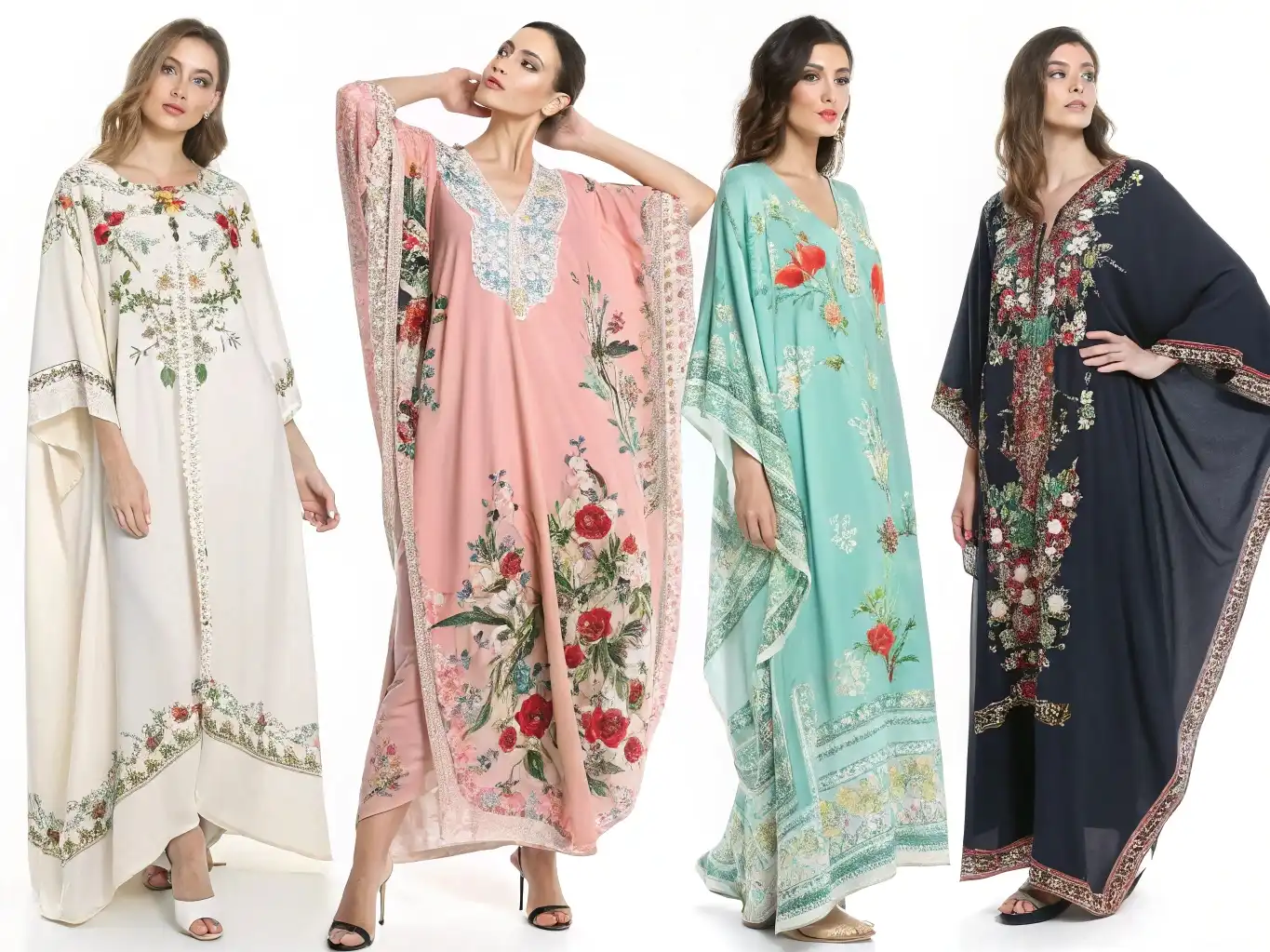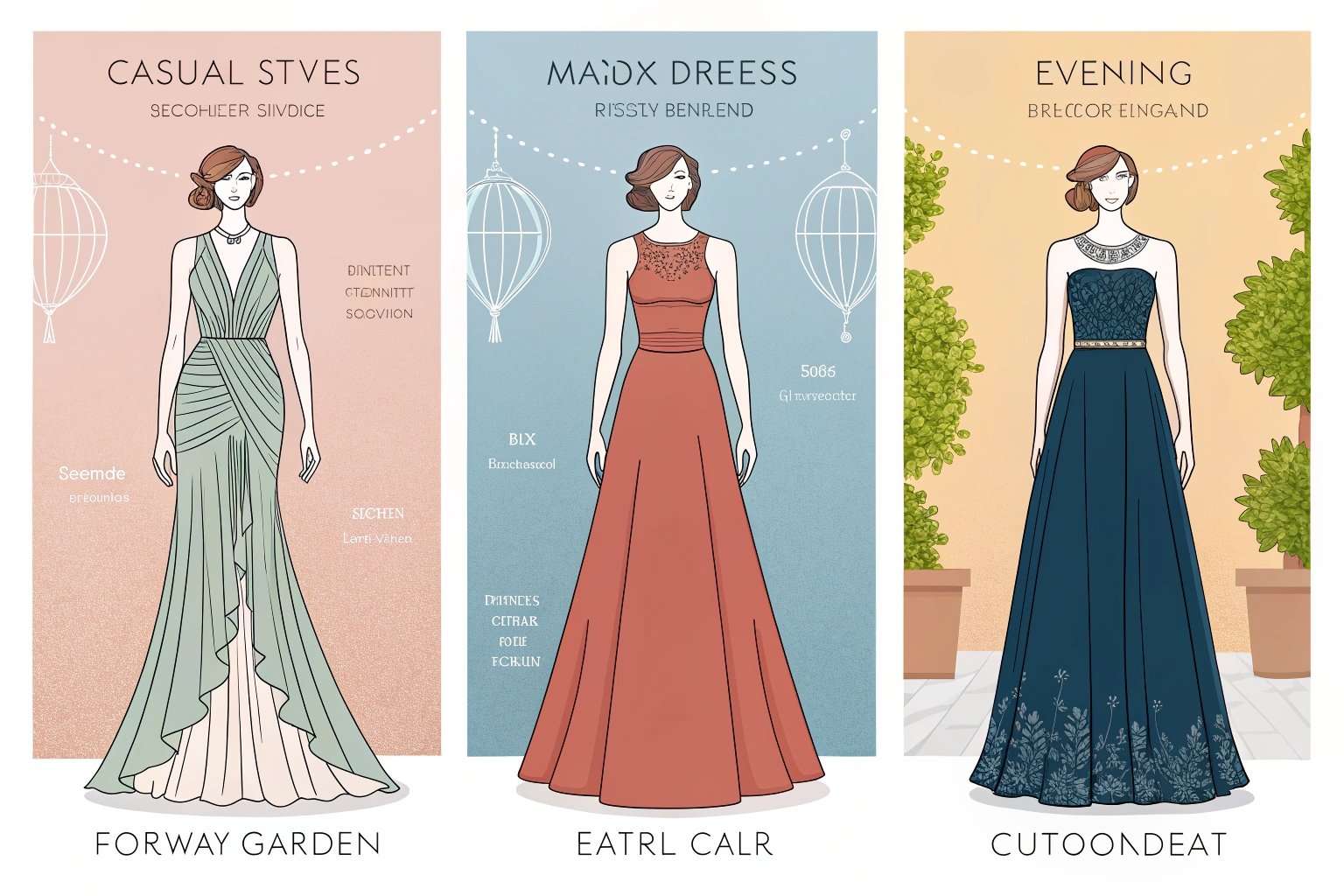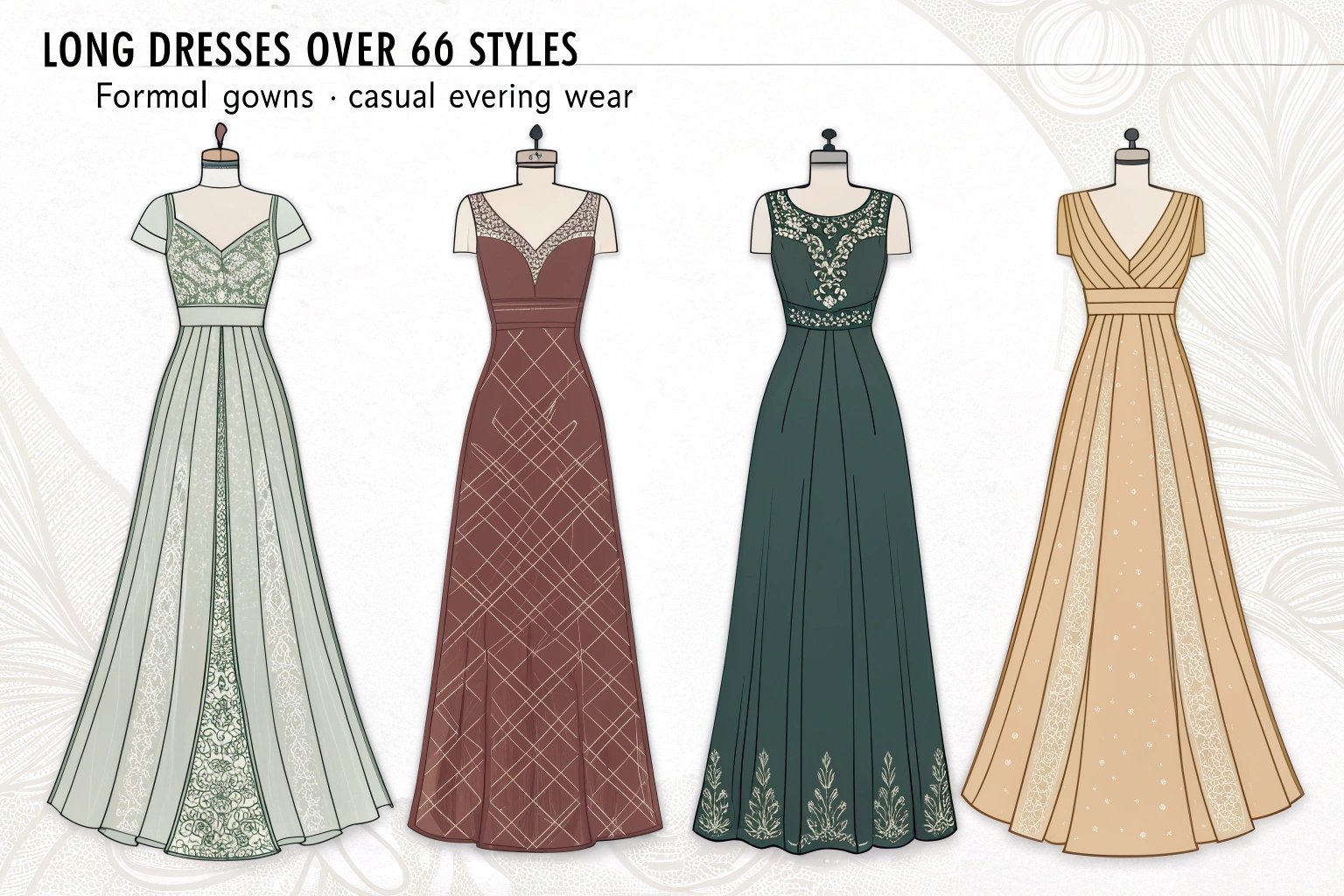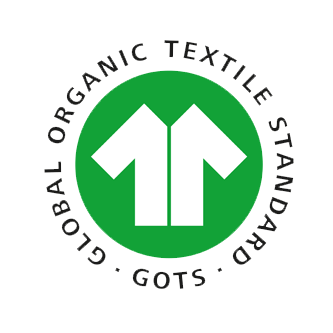In the first three installments of our Types of Dresses series, we’ve taken a step-by-step journey through the expansive world of women’s dresses. Part 1 introduced the essential silhouettes, lengths, and neckline styles that define more than 80 dress types. Part 2 explored the relationships between fabric, function, and form—helping readers understand how to select the right dress for every occasion and body type. Part 3 dove into practical styling strategies, regional preferences, and body-shape alignment, offering a more tailored approach to dress design and selection.
Now, in Part 4, we continue this exploration by shifting the focus to the business impact of dress styles. From pricing strategies and production complexity to inventory planning and merchandising logic, this chapter uncovers how different dress types perform in real-world fashion supply chains. These insights will help brands, buyers, and wholesalers make more data-informed decisions—translating style into profit and turning creative choices into scalable, commercial success.
1920s Flapper Dress
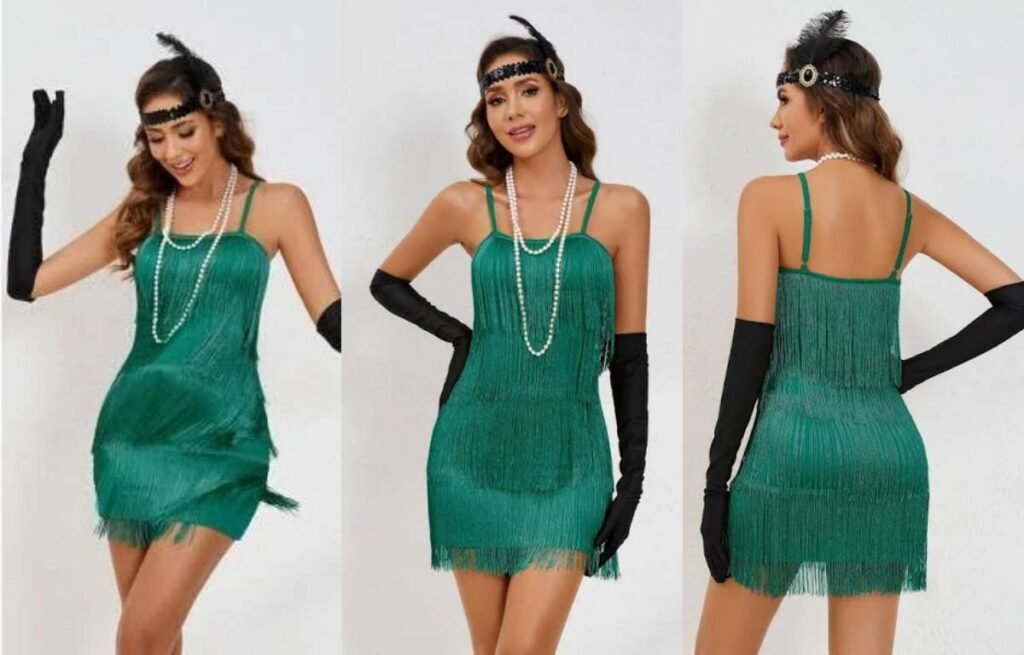
1920s Flapper Dress: Vintage Glamour with a Rebellious Spirit
The 1920s flapper dress is iconic for its loose fit, dropped waist, and fringe or sequin embellishments—a symbol of fashion rebellion and freedom.
This dress broke away from the corseted styles of previous eras, offering women a new silhouette that emphasized movement, fun, and independence. It’s instantly recognizable and still influences modern eveningwear.
Why does the flapper dress still inspire modern fashion?
The flapper dress isn’t just nostalgic—it reshaped how we think about women’s clothing.
Its relaxed fit, bold details, and joyful energy make it both a fashion statement and a cultural icon. It remains a favorite for themed parties, vintage lovers, and designers seeking to bring old-world glamour to modern wardrobes.
The Design and Legacy of the 1920s Flapper Dress
A Break from Tradition
The flapper dress emerged in a time of massive social change. Women were gaining more freedom—socially, politically, and stylistically. The dress reflected this shift:
- Dropped waistlines created a straight, androgynous silhouette.
- Shorter hemlines revealed the legs—a major statement for the era.
- No corsets meant more comfort and mobility, representing liberation.
This design gave women the ability to dance freely, especially the Charleston, which was popular at jazz clubs and speakeasies.
Design Elements That Define It
| Feature | Description |
|---|---|
| Silhouette | Straight, loose, dropped waist |
| Embellishments | Sequins, beads, fringe, feathers |
| Necklines | Scoop, bateau, or V-neck |
| Hemlines | Knee-length or slightly above |
| Fabrics | Silk, chiffon, satin, and tulle |
The dress was meant to shimmer and move. Fringe and beading weren’t just decorative—they amplified motion, turning every step or dance move into part of the performance.
Why It Flatters Many Body Types
Because of its straight cut and relaxed fit, the flapper dress suits various figures:
- Petite women: The dress elongates the frame without overwhelming it.
- Curvy bodies: It offers a comfortable fit that doesn’t cling but still looks elegant.
- Athletic builds: The embellishments add texture and volume, creating shape.
The key is proportion. Shorter women may opt for slightly higher hemlines, while taller frames can embrace the full drop-waist look.
Cultural Impact and Modern Adaptations
The flapper dress became a symbol of female empowerment. It still appears on runways, especially in:
- Gatsby-inspired eveningwear
- Bridal fashion with art deco beading
- Cocktail dresses that incorporate fringe or sequins
Contemporary designers often reinterpret the flapper look using modern cuts and fabrics while keeping the sparkle and movement intact.
Styling Tips
- Shoes: Classic T-strap heels or Mary Janes
- Accessories: Feathered headbands, long pearls, or a beaded clutch
- Hair & Makeup: Finger waves and bold red lips for full 1920s glam
1930s Bias-Cut Dress
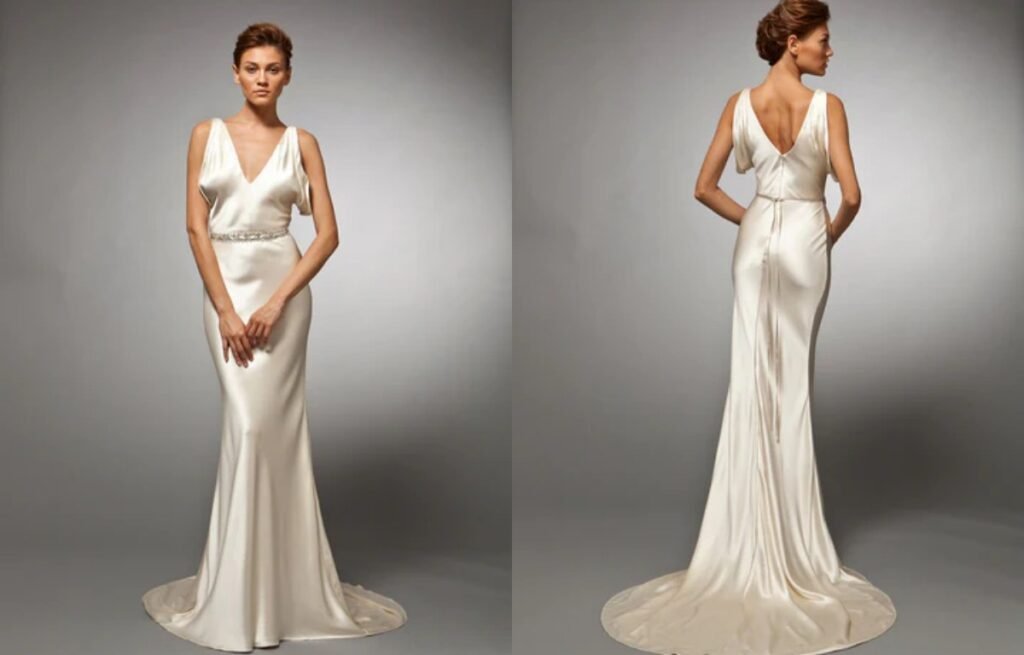
1930s Bias-Cut Dress: Fluid Elegance in Motion
The 1930s bias-cut dress is known for its graceful drape and body-skimming silhouette, creating effortless femininity.
Cut diagonally across the fabric’s grain, this dress hugs the body naturally without tight seams, flowing with every movement. It became iconic during the 1930s and remains a go-to silhouette for formal wear today.
Why is the Bias-Cut Dress from the 1930s Still Relevant?
It flatters without force and feels luxurious without effort.
The bias cut allows fabric to fall smoothly along the body, enhancing curves and natural motion. It creates a seamless look that feels soft, elegant, and timeless.
Understanding the Power of the 1930s Bias-Cut
Though it looks simple, the bias-cut dress is a technical achievement in garment construction. Here’s why it’s so impactful:
What Is “Bias Cut”?
Bias refers to fabric cut at a 45-degree angle from the straight grain. This diagonal direction gives the material stretch, fluidity, and natural cling.
- On the grain: Stable, structured, with limited movement.
- On the bias: Stretchy, soft, and flexible, shaping itself around the body.
This method was famously used by designer Madeleine Vionnet, who turned dressmaking into sculpture.
Body-Skimming Without Tightness
Unlike fitted dresses with darts and seams, the bias-cut uses gravity and fabric stretch to contour the body.
- No zippers or stiff structure needed
- Ideal for highlighting natural curves
- Moves with the body rather than against it
It flatters hourglass, pear, and straight figures alike, adapting to each body’s shape without extra bulk.
Signature Fabrics
The success of a bias-cut design depends on fabric choice. Lightweight, drapey textiles work best:
- Silk charmeuse
- Satin
- Rayon crepe
- Light viscose blends
Heavier fabrics may lose fluidity and feel stiff, defeating the purpose of the cut.
Design Details to Watch For
- Cowl or draped necklines enhance the soft fall of the fabric.
- Backless or low-back cuts often appear in bias dresses for added sensuality.
- Floor-length hems give a vintage Hollywood feel.
- Minimal seams preserve fluid movement.
Bias-Cut vs. Other Silhouettes
| Feature | Bias-Cut Dress | Fitted Sheath | A-Line Dress |
|---|---|---|---|
| Fit Method | Fabric drape | Tailored seams | Structured flare |
| Comfort Level | High | Moderate | High |
| Best Fabrics | Soft, flowing | Woven, slightly stiff | Cotton, poplin |
| Style Vibe | Romantic, vintage | Sleek, modern | Casual, versatile |
How to Style the 1930s Bias-Cut Dress
- For elegance: Pair with vintage heels and red lips.
- For modern twist: Layer with a blazer or cropped jacket.
- For evening wear: Use silk or satin, with minimal accessories.
- For daytime chic: Choose matte fabrics and pair with boots or flats.
1950s Rockabilly Dress
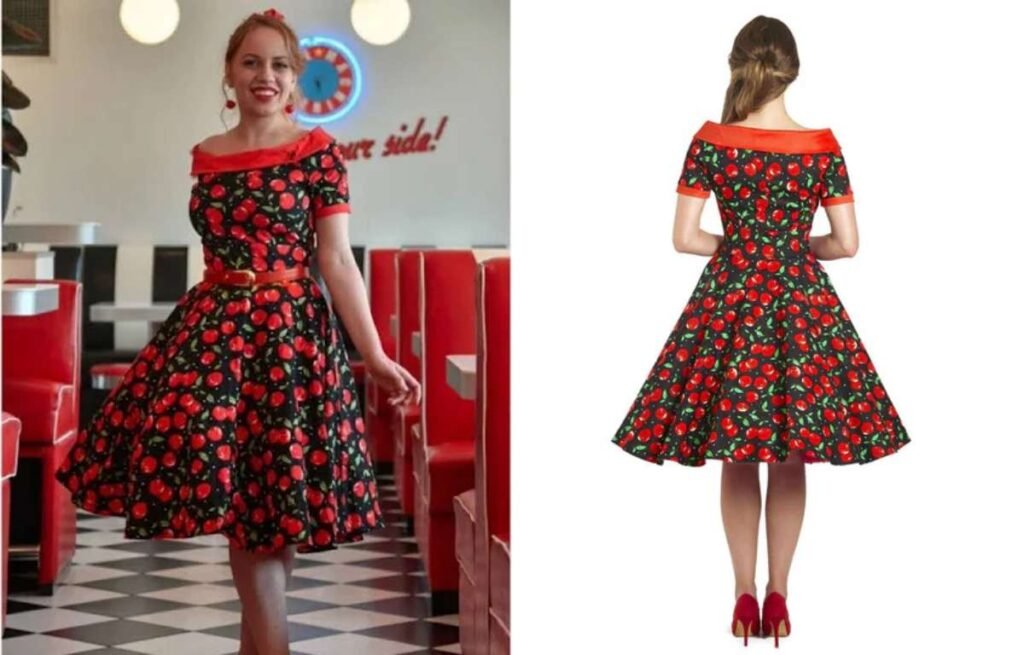
1950s Rockabilly Dress: Retro Style with a Rebel Twist
The 1950s Rockabilly dress blends vintage charm with youthful energy, rooted in the early rock-and-roll era.
It’s known for its fitted bodice, cinched waist, and full swing skirt—often paired with bold prints, polka dots, or bright colors. The style celebrates curves and adds playful attitude to classic femininity.
What makes the Rockabilly dress so iconic?
This dress represents more than just a silhouette—it captures a cultural moment of rebellion and freedom.
The Rockabilly dress combines structure and flair to highlight the waist and create a dramatic hourglass shape. It’s playful, bold, and timeless.
The Design Impact of the 1950s Rockabilly Dress
The Rockabilly dress emerged during a unique time when fashion, music, and youth culture collided. It reflected independence, boldness, and a break from traditional fashion norms.
Key Features of Rockabilly Dresses
- Fitted Bodice: Accentuates the bust and defines the upper body.
- Cinched Waist: Often enhanced with a wide belt to emphasize curves.
- Full Skirt: Designed to swing with movement—sometimes worn with petticoats.
- Prints & Colors: Think polka dots, cherries, leopard prints, and bold reds, blacks, and whites.
These design elements were inspired by 1950s pin-up fashion, but Rockabilly added a rebellious twist with louder prints and attitude.
Why It Still Works Today
- Flattering Fit: The hourglass cut suits many body types.
- Vintage Appeal: Nostalgic without feeling outdated.
- Statement Look: Perfect for themed events or standout everyday style.
- DIY-Friendly: Many Rockabilly fans mix modern and vintage elements for a personalized look.
Rockabilly Dress vs. Other Vintage Styles
| Style | Fit & Silhouette | Key Detail | Vibe |
|---|---|---|---|
| Rockabilly Dress | Fitted top, full skirt | Prints, belts, swing shape | Bold, playful, retro |
| 1940s Tea Dress | Modest fit-and-flare | Subtle prints, shorter hem | Feminine, classic |
| 1960s Mod Dress | Straight, boxy | Mini length, clean lines | Youthful, edgy |
Best Fabrics and Styling Tips
Rockabilly dresses often use cotton or cotton blends, which hold structure and support full skirts. Some versions may include a hint of stretch for comfort.
Styling Tips:
- Add a petticoat for extra volume.
- Pair with winged eyeliner, red lipstick, and retro curls for a full vintage look.
- Match with kitten heels or saddle shoes for authenticity.
- Use a contrast belt to highlight the waist even more.
1960s Mod Dress
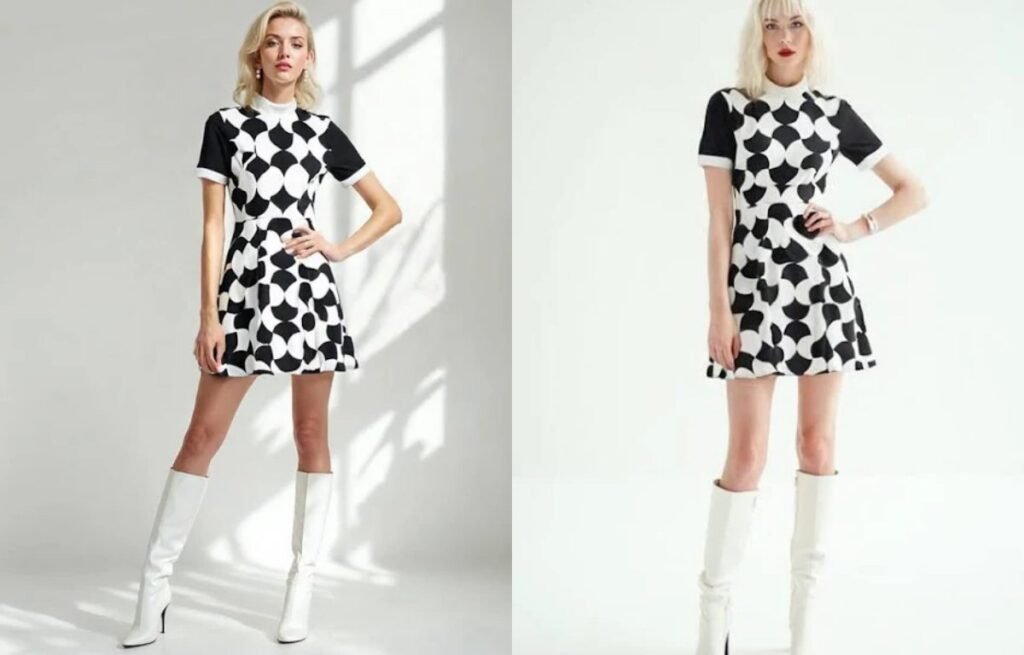
1960s Mod Dress: A Bold and Graphic Fashion Icon
The 1960s Mod Dress is known for its clean lines, bright colors, and geometric prints—instantly recognizable and rooted in youth-driven rebellion.
This style features a short, boxy silhouette often paired with bold patterns, color blocking, and high necklines. It represents a major shift in women’s fashion, breaking away from traditional femininity.
Why did the 1960s Mod Dress redefine fashion?
This style wasn’t just about clothes—it reflected a cultural shift.
The mod dress symbolized freedom, youth, and simplicity in a time when fashion was rapidly moving away from restrictive silhouettes. It was playful, easy to wear, and bold enough to make a statement without trying too hard.
The Lasting Influence of the 1960s Mod Dress
The 1960s Mod Dress wasn’t just a trend—it reshaped fashion thinking. Its form and attitude still echo in today’s designs.
A New Silhouette for a New Generation
Before the 1960s, women’s dresses were often fitted, structured, and highly feminine. The Mod Dress changed that with its:
- Straight, shift-style cut: Looser, unfitted, and shorter
- Youth-driven look: Designed for movement and freedom
- No waist emphasis: The shape was simple and androgynous
This silhouette liberated women from tight waists and heavy skirts. It was especially popular among teenagers and young adults, signaling independence from earlier generations.
Key Design Elements
- Hemline: Short, often above the knee
- Neckline: High, sometimes mock-neck
- Sleeves: Short or long, usually set-in and clean
- Prints: Geometric shapes, pop art, op art, color-block panels
- Colors: Bold primaries—red, blue, yellow, black and white
Cultural Impact
The Mod Dress was heavily influenced by London’s youth culture, especially icons like Twiggy, Mary Quant, and the rise of boutiques on Carnaby Street.
- Twiggy made the look globally famous with her doll-like features and short dresses.
- Mary Quant, credited with popularizing the mini skirt, turned Mod fashion into a lifestyle—young, daring, and fast-moving.
This dress wasn’t just about appearance—it was wearable confidence.
How It Continues to Influence Fashion Today
Designers still draw on the Mod Dress for inspiration, especially in:
- Minimalist silhouettes: Clean A-line cuts in modern dresses
- Color-blocking: A design staple across modern collections
- Retro-inspired prints: Especially in spring/summer edits
- Youth-driven branding: For Gen Z, the Mod aesthetic feels fresh again
Mod Dress vs. Other Retro Styles
| Style | Silhouette | Key Features | Mood |
|---|---|---|---|
| 1960s Mod Dress | Short, straight | Bold prints, high necklines | Playful, youthful |
| 1950s Fit-and-Flare | Cinched waist | Full skirt, feminine details | Romantic, vintage |
| 1970s Boho Dress | Flowy, relaxed | Ruffles, earthy tones | Free-spirited, casual |
Best Fabrics for 1960s Mod Dresses
The Mod look relies on crisp lines and bold visuals. Ideal fabrics include:
- Twill or cotton blends: Hold the shape well for shift styles
- Polyester: Common in vintage mod pieces, easy-care
- Jersey: Comfortable with light stretch for movement
- Satin or crepe: Adds a modern twist to retro cuts
Styling Tips
To modernize the Mod:
- Pair with knee-high boots or platform shoes
- Keep accessories minimal—let the print shine
- Try a short bob or sleek ponytail for a retro finish
- Use statement eye makeup to mirror the ’60s look
Grecian Dress
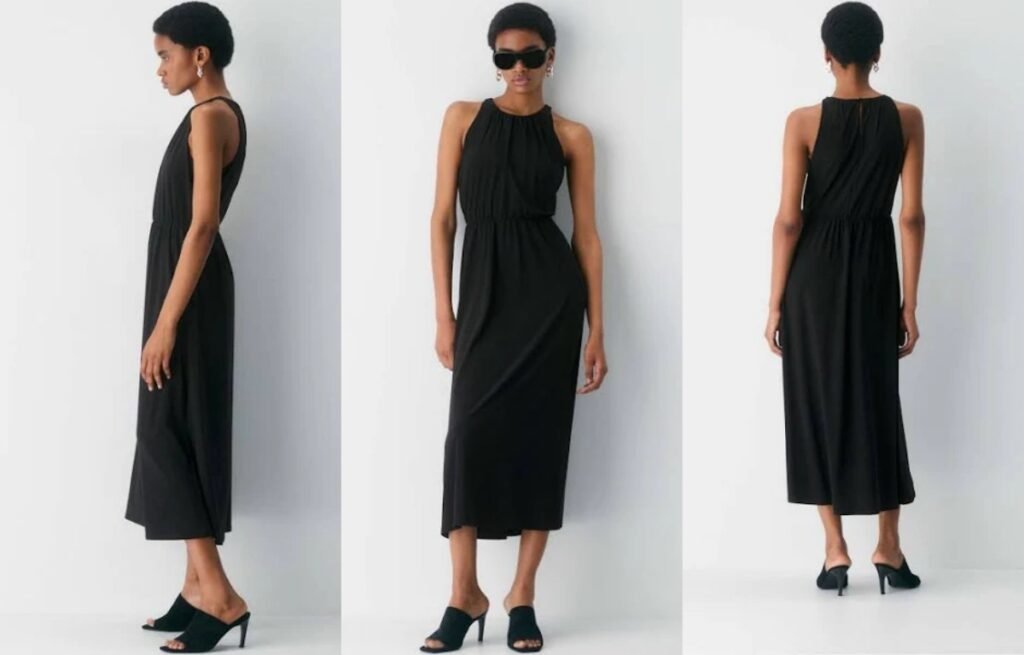
Grecian Dress: Effortlessly Elegant and Timeless
The Grecian dress is known for its draped fabric, flowing lines, and graceful silhouette inspired by ancient Greek fashion.
Characterized by one-shoulder designs, pleats, and soft gathers, this dress creates a statuesque look that flatters the natural curves of the body. It’s a favorite for formal events due to its ethereal and elevated appearance.
What makes the Grecian dress so graceful and versatile?
The Grecian dress is elegant because of its fluid construction and balanced proportions.
It drapes the body in soft folds, creating a slimming effect while adding movement and height. Whether in floor-length or midi form, it’s a style that suits most body types and is especially striking in evening or bridal wear.
Understanding the Design Strength of the Grecian Dress
Grecian dresses may seem simple, but their strength lies in sophisticated draping and strategic styling that flatters without excess structure.
Draping and Silhouette
The beauty of the Grecian dress comes from how it falls naturally along the body. Unlike structured dresses that rely on tailoring, this style uses fabric weight and gravity:
- Vertical pleats create length and soften the overall form.
- Asymmetrical elements, such as a one-shoulder neckline, add visual interest while balancing the upper body.
- Cinched waists using sashes or integrated belts help define shape without adding bulk.
This soft approach to silhouette design makes the Grecian dress ideal for evening gowns, bridesmaid dresses, or any occasion where flow and elegance are key.
Ideal Body Types
This dress works well on many figures:
- Tall or slender women: Enhances elegance with long vertical lines.
- Curvy bodies: Draping smooths over curves without clinging.
- Pear-shaped figures: Draws attention upward with asymmetry and neckline detail.
Fabric and Movement
The success of a Grecian dress depends on fabric. Lightweight, flowing textiles enhance its shape:
- Chiffon: Sheer and fluid, perfect for layering and movement.
- Silk jersey: Offers stretch and softness while maintaining drape.
- Georgette: Light with a slight texture, ideal for pleats.
Heavier fabrics should be avoided, as they can disrupt the natural flow that defines this style.
Modern Interpretations
Today’s Grecian dresses come in many variations:
- With metallic trims or beaded straps for formal wear
- Minimalist cuts with clean lines for modern brides
- Short Grecian dresses for cocktail or resort wear
Designers use the Grecian silhouette not just for traditional gowns, but for updated, contemporary collections as well.
Grecian vs. Other Draped Styles
| Feature | Grecian Dress | Empire Waist Dress | Column Dress |
|---|---|---|---|
| Silhouette | Flowy, draped, often asymmetric | High-waisted, soft flow | Slim and straight |
| Structure | Soft, elegant drape | Gentle shaping | Minimal tailoring |
| Best For | Formal events, weddings | Casual/formal hybrid | Tall, lean figures |
| Neckline Variation | One-shoulder, halter | Scoop, square | Strapless, high neck |
Best Fabrics for Grecian Dresses
To maintain a soft, elegant flow, the best fabric options include:
- Chiffon: Lightweight and sheer, ideal for layering and pleating.
- Silk Jersey: Stretchy and smooth, offers comfort and drape.
- Georgette: Flowy and textured, adds subtle structure.
- Crepe: Light with a matte finish, suitable for more refined looks.
Victorian Gown
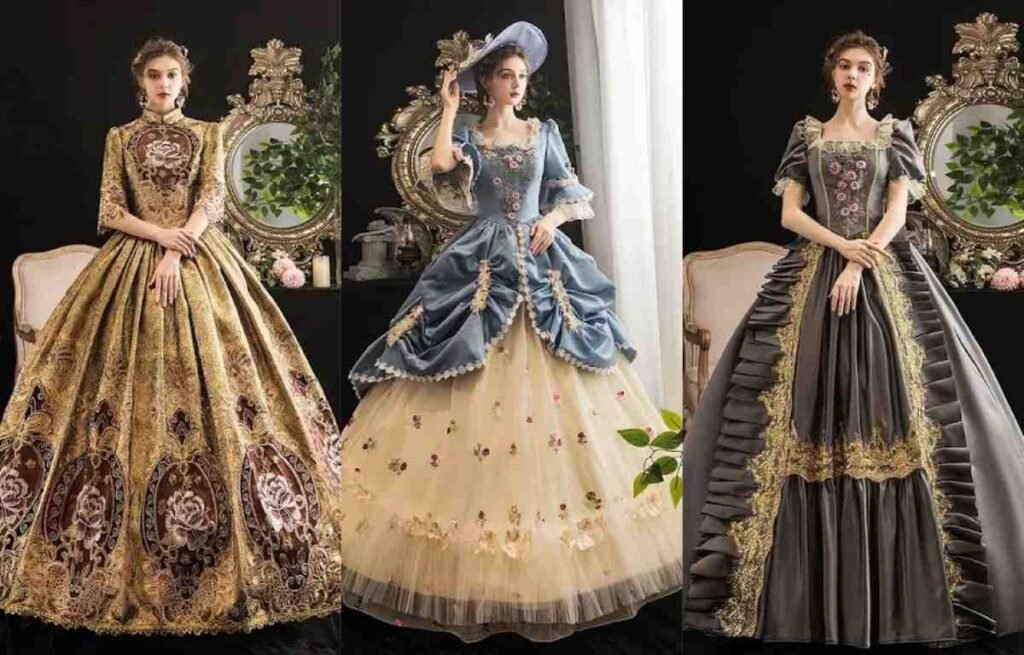
Victorian Gown: The Epitome of Romance and Elegance
The Victorian gown is one of the most iconic historical dress styles, known for its rich fabrics, intricate details, and timeless femininity.
Defined by high necklines, corseted waists, full skirts, and ornate embellishments, the Victorian gown reflects elegance and romanticism. Today, it continues to inspire bridal, evening, and vintage-style collections.
Why does the Victorian gown remain a strong fashion influence?
Its blend of historical structure and ornate beauty keeps it relevant.
Victorian gowns offer a dramatic silhouette that emphasizes the waist, elongates the figure, and carries an unmatched sense of vintage romance. Designers often revisit this style to add drama or historical depth to a collection.
Understanding the Lasting Appeal of the Victorian Gown
Victorian gowns are more than just historical costumes—they’re fashion landmarks that blend culture, structure, and emotion. Here’s why they continue to resonate:
Distinct Silhouette and Structure
Victorian gowns are built around a strong shape:
- Corseted waist: Defines the torso, creating an hourglass figure.
- Full skirt: Often supported by crinolines or layers of fabric, adds volume and movement.
- High neckline and long sleeves: Offer modesty while maintaining elegance.
- Bustle or train: Enhances back volume and adds a regal touch.
This structure helps sculpt the body visually, making the wearer appear taller, slimmer, and more poised.
Fabrics and Embellishments
Victorian gowns typically use rich, luxurious materials:
- Silk, satin, velvet: For body and drape.
- Lace, embroidery, beading: For surface detail and texture.
- Tulle, organza: To add lightness and volume in modern interpretations.
Today’s designers often blend traditional and modern elements, using sheer sleeves, lighter materials, or digital lace prints to modernize the look.
Symbolism and Cultural Impact
Victorian gowns symbolize more than just style—they represent:
- Femininity and grace
- Historical nostalgia
- Luxury and status
They’re often chosen for bridal wear, costume events, or high-fashion editorials, where storytelling and silhouette both matter.
Victorian Gown vs. Other Historical Styles
| Style | Shape | Key Features | Mood/Impression |
|---|---|---|---|
| Victorian Gown | Hourglass, dramatic skirt | Corset, lace, long sleeves | Romantic, vintage, formal |
| Empire Waist Gown | Raised waist, flowy | High waist, minimal bodice | Elegant, light |
| Renaissance Dress | Voluminous, layered | Square neck, bell sleeves | Regal, ornate |
| Edwardian Dress | Slim, S-curve silhouette | High neck, lighter structure | Graceful, transitional |
Best Occasions and Modern Interpretations
Victorian gowns are most often seen in:
- Weddings: Lace corseted bridal gowns with cathedral trains
- Runway/couture: Dramatic evening dresses with historical references
- Vintage/retro brands: Everyday wear inspired by the Victorian silhouette
- Costume or themed events: Faithful recreations with authentic details
Modern designers may keep the corset and lace but soften the skirt, lower the neckline, or use lighter fabrics to update the style.
Edwardian Tea Dress
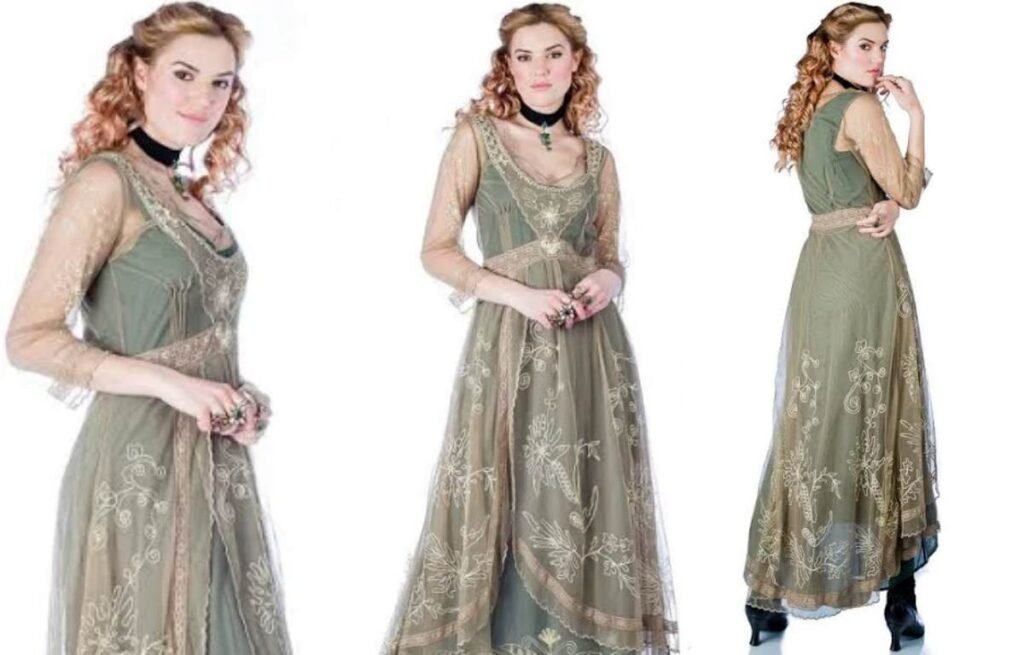
Edwardian Tea Dress: Vintage Romance with Modern Appeal
The Edwardian tea dress is a nod to early 1900s fashion, defined by soft silhouettes, delicate details, and timeless femininity.
This dress typically features high necklines, lace trims, and flowing skirts that fall mid-calf, designed for elegant daytime events like afternoon tea. Today, it’s reinterpreted in both vintage-inspired and contemporary collections.
Why does the Edwardian tea dress still feel relevant?
Despite its vintage roots, the Edwardian tea dress feels fresh, even in modern wardrobes.
It blends elegance and ease, making it ideal for occasions that call for soft sophistication without being too formal. Its structure flatters many body types while offering a unique alternative to today’s common dress styles.
The Lasting Appeal of the Edwardian Tea Dress
The Edwardian tea dress may seem specific to a historical era, but its design principles are surprisingly timeless. Here’s why it still resonates with modern fashion lovers and designers:
Rooted in History, Yet Effortless Today
Originally worn by upper-class women during daytime social gatherings, tea dresses reflected both modesty and refinement. The designs featured:
- High lace-trimmed necklines
- Light, breathable fabrics like cotton lawn or silk
- Empire or natural waistlines
- Detailed embroidery or pintucks
Today, designers preserve these elements while making adjustments for comfort and versatility—like shorter hemlines, stretch fabrics, or looser bodices.
A Universally Flattering Shape
Edwardian tea dresses often emphasize the waist while flowing gently over the hips and legs. This structure creates a soft hourglass silhouette without being tight or restrictive.
- For pear-shaped figures: The skirt floats over the hips.
- For athletic builds: The lace and gathers add softness and curves.
- For petite women: The vertical detailing elongates the frame.
- For fuller figures: The gentle A-line cut provides comfort and shape.
Feminine, But Not Overstated
The beauty of the tea dress is in its restraint. Unlike bold evening gowns or sharply tailored pieces, this dress relies on soft lines, delicate trims, and romantic fabrics. That makes it easy to style across different settings—from garden parties to casual brunches.
Modern Interpretations
Designers now experiment with:
- Pastel or floral prints instead of plain white
- Short sleeves or sleeveless cuts for warmer climates
- Sheer overlays or tiered skirts for added texture
- Midi-length or mini versions for a younger look
These updates allow the Edwardian tea dress to move seamlessly into modern wardrobes without losing its historic charm.
Edwardian Tea Dress vs. Similar Styles
| Dress Style | Structure | Key Features | Vibe |
|---|---|---|---|
| Edwardian Tea Dress | Flowing, waist-defined | Lace, high neck, vintage trims | Romantic, refined |
| Empire Waist Dress | High waistline | Loose skirt, soft fabrics | Feminine, bohemian |
| Prairie Dress | Relaxed, tiered | Ruffles, puff sleeves, florals | Rustic, nostalgic |
| Slip Dress | Straight, minimal | Spaghetti straps, silky texture | Sleek, modern |
Best Fabrics and Styling Tips
Lightweight fabrics with texture and drape work best—think cotton voile, silk blends, or soft chiffon.
- Lace panels or trims elevate the vintage feel
- Florals or broderie anglaise enhance the romantic tone
- Pair with: ankle boots, strappy sandals, or vintage-inspired flats
- Add layers: like a knit cardigan, denim jacket, or structured blazer for contrast
Prairie Dress
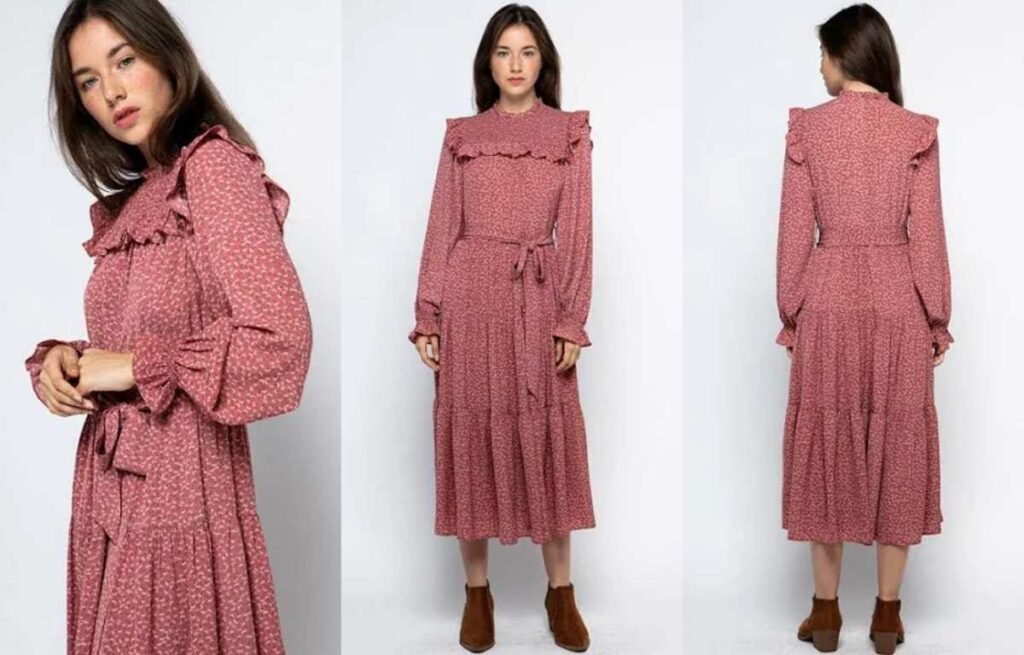
Prairie Dress: Romantic, Vintage, and Effortlessly Modest
The prairie dress brings a nostalgic, countryside feel to modern wardrobes. It’s modest yet romantic, often with a vintage silhouette.
Characterized by high necklines, ruffled trims, puff sleeves, and ankle-grazing hemlines, the prairie dress channels 19th-century Americana with a modern twist. It’s flowy, soft, and ideal for both everyday wear and vintage-inspired looks.
What makes the prairie dress different from other vintage-inspired styles?
It’s not just about looking retro—prairie dresses balance softness, practicality, and timeless charm.
The prairie dress stands out with its modest cut, layered textures, and feminine details like lace, floral prints, and tiered skirts. Unlike more fitted vintage styles, it emphasizes comfort and ease.
Why the Prairie Dress Has Enduring Appeal
The prairie dress may seem old-fashioned, but its resurgence in recent years shows its deep fashion value. Here’s why it continues to resonate:
1. Feminine Without Being Revealing
The prairie dress covers much of the body—long sleeves, high necklines, longer lengths—yet still feels romantic and delicate. It’s a perfect balance for women who want femininity without showing too much skin.
- Puff sleeves add volume and a soft shoulder line
- Ruffles and lace trims bring subtle texture
- Fitted bodices paired with flowing skirts offer flattering silhouettes
2. Comfort and Function
Historically, prairie dresses were designed for functionality—easy movement, durable fabric, weather protection. Today’s versions stay true to that DNA but update it for style and comfort.
- Elastic waists or smocking allow for flexible fit
- Tiered skirts move beautifully and are forgiving on all body shapes
- Natural fabrics like cotton or linen make it breathable and wearable for everyday
3. Versatile Styling for Modern Wardrobes
Though rooted in history, prairie dresses can be styled in modern ways:
- With boots and a leather jacket for an edgy contrast
- Layered with knits in colder months
- Belted to define the waist for a more structured shape
- Worn loose for a relaxed, cottagecore vibe
It bridges the gap between romantic fashion and practicality, making it ideal for day-to-day wear, weekend getaways, or styled editorial looks.
Prairie Dress vs. Similar Styles
| Style | Key Features | Fit | Vibe |
|---|---|---|---|
| Prairie Dress | High neck, long sleeves, tiered skirt | Relaxed, modest | Vintage, romantic |
| Boho Maxi Dress | Loose fit, embroidery, open neckline | Very flowy | Free-spirited, earthy |
| Cottagecore Dress | Puff sleeves, soft florals, apron waist | Semi-structured | Whimsical, dreamy |
| Victorian Dress | High structure, corset waist, lace | Fitted and ornate | Formal, historic |
Which Fabrics and Prints Suit Prairie Dresses Best?
Cotton, linen, voile, and lightweight blends are ideal for comfort and breathability. These fabrics hold structure without being stiff.
Popular prints and textures:
- Micro florals and ditsy prints for vintage charm
- Eyelet lace or broderie anglaise for added texture
- Solid earth tones like cream, olive, or dusty rose for a modern take
Peasant Dress
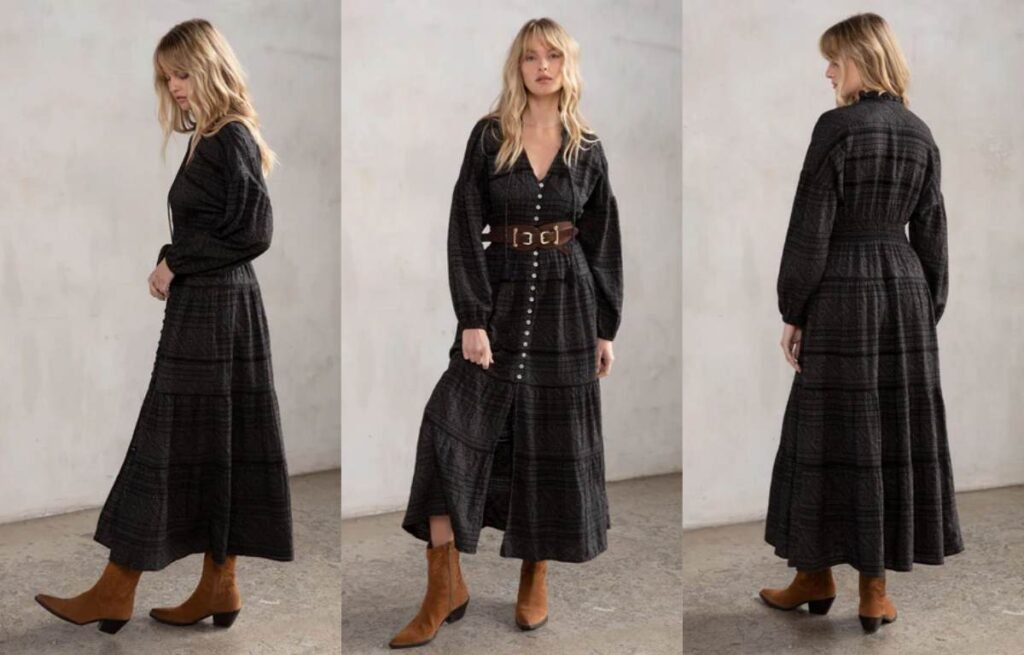
Peasant Dress: Effortless, Bohemian, and Timeless
The peasant dress is known for its relaxed fit, gathered neckline, and flowy silhouette—blending comfort and romantic style.
Peasant dresses often feature soft fabrics, puffed sleeves, and loose shapes, inspired by traditional European folk wear. They’re versatile, easy to wear, and always feel relaxed and feminine.
Why has the peasant dress stayed popular for so long?
The peasant dress blends comfort, ease, and timeless design. It adapts to trends while keeping its vintage charm.
Its breezy shape and soft neckline flatter many body types, and its layered look fits into modern boho and minimalist wardrobes.
Understanding the Peasant Dress in Fashion Design
The peasant dress may seem like a simple, laid-back style—but it carries design depth and cultural influence. Let’s explore why it continues to show up in both mass fashion and high-end collections.
Historical Roots and Cultural Impact
The peasant dress originates from traditional Eastern European folk clothing, particularly from regions like Romania, Hungary, and Ukraine. It was worn for its practicality—loose, breathable, and easy to move in. Over time, designers reimagined it as a romantic, free-spirited fashion staple.
Design Elements That Make It Stand Out
Key features of a peasant dress:
- Neckline: Usually gathered, elastic, or tie-front—can be worn on or off-shoulder
- Sleeves: Puff or balloon-shaped, often with elastic cuffs
- Bodice: Loose-fitting, sometimes with smocking or a drawstring waist
- Hemline: Often midi or maxi, with ruffles or tiered panels
- Fabric: Lightweight cotton, gauze, linen, or rayon
These elements give the dress a soft structure, allowing for movement and breathability without sacrificing shape.
Body Type Compatibility
The peasant dress is inclusive and flattering when styled right:
- Pear-shaped: Balances wider hips with volume on top
- Apple-shaped: Loose middle helps mask the waist, while neckline draws focus upward
- Petite: Choose a shorter length or defined waist to avoid looking overwhelmed
- Tall figures: Midi and maxi versions suit longer frames perfectly
Peasant Dress vs. Similar Styles
| Style Type | Fit | Key Feature | Vibe |
|---|---|---|---|
| Peasant Dress | Loose, flowy | Gathered neckline, sleeves | Boho, folk |
| Empire Dress | High waistline | Raised seam below bust | Romantic, soft |
| Smock Dress | Very loose | Boxy shape, minimal seams | Relaxed, minimal |
| Prairie Dress | Structured bodice | Ruffles, tiers | Vintage, modest |
Why Designers Keep Revisiting It
Peasant dresses fit with key trends: comfort, natural fabrics, and nostalgic silhouettes. They’re also easy to produce in both fast fashion and slow fashion models. Minimal cutting, lower fabric waste, and adaptable sizing make them production-friendly too.
They also align well with eco-conscious branding—especially when made from organic cotton or undyed fabrics.
Best Fabrics for Peasant Dresses
- Cotton gauze: Lightweight and breathable for summer
- Rayon/viscose: Soft drape, perfect for a dressier look
- Linen blends: Ideal for structured yet breathable styles
- Crinkled cotton: Adds texture with minimal ironing
Styling Tips
- Casual: Pair with flat sandals and a straw bag
- Boho: Add a wide-brim hat and suede boots
- Evening: Choose a darker color, layer with a belt and heeled mules
- Layered: Wear over a turtleneck in cooler seasons
Gothic Dress
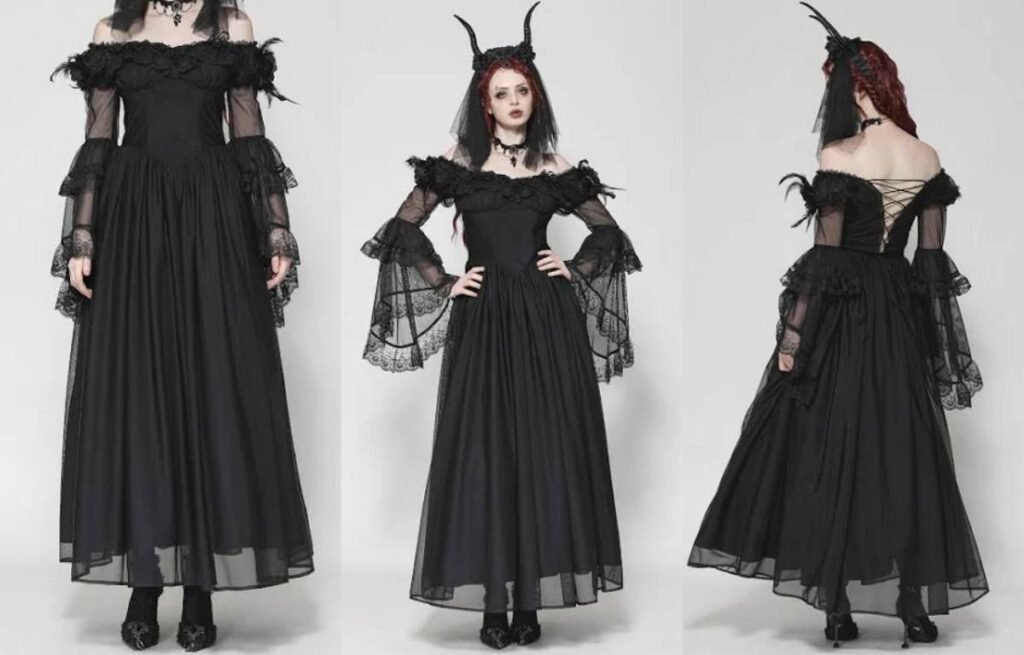
Gothic Dress: Dark, Dramatic, and Iconic
The Gothic dress is more than a fashion statement—it’s a subculture rooted in dark aesthetics and romantic rebellion.
Defined by dark colors, rich fabrics, and ornate details like lace, corsetry, and layered skirts, Gothic dresses channel a mysterious, powerful femininity. They’re worn both in everyday alternative fashion and dramatic editorial looks.
What makes Gothic dresses stand out in modern fashion?
Gothic dresses have a strong visual identity.
Their use of black tones, lace textures, high collars, and corset-style waists creates a look that’s both bold and nostalgic. It’s fashion with drama, emotion, and historic roots.
The Essence and Evolution of Gothic Dresses
Gothic dresses aren’t just about wearing black—they reflect history, rebellion, and personal style. Here’s a deeper look:
1. Origins and Influence
Gothic fashion has roots in the Victorian era, borrowing from mourning dresses, corsets, and petticoats. Over time, it blended with punk, metal, and alternative cultures to become a key part of the modern Goth aesthetic.
- Victorian Gothic: High necklines, long sleeves, and layered skirts.
- Romantic Gothic: Flowing fabrics, velvet, and lace.
- Punk-Influenced Gothic: Leather details, fishnet layers, harnesses.
2. Key Design Features
| Element | Description |
|---|---|
| Color Palette | Primarily black, deep red, purple, or navy |
| Silhouette | Fitted bodice with flared or floor-length skirt |
| Fabrics | Velvet, lace, tulle, satin, leather |
| Details | Corsets, ruffles, bell sleeves, chokers |
These elements give the dress a sense of drama and fantasy, while also highlighting craftsmanship and tailoring.
3. Body Type Compatibility
Though dramatic, Gothic dresses can be flattering for many:
- Hourglass: Corset waists define curves.
- Rectangle: Layering and structure add shape.
- Pear-shaped: A-line or layered skirts balance the figure.
- Petite: Shorter Gothic styles with lace overlays create length without bulk.
4. Cultural and Emotional Impact
Gothic fashion is not only visual—it’s emotional. It’s worn as a form of self-expression and connection to darker romantic themes. Many who wear Gothic dresses use them to project mystery, elegance, or non-conformity.
5. Versatility and Modern Takes
While traditionally seen in subcultural settings, Gothic dresses are now adapted into:
- Evening wear with dark glam
- Streetwear with minimal Gothic influence
- Editorial/fashion shows for high-drama looks
Modern Gothic fashion also crosses into Lolita styles, witchcore, and dark academia, broadening its appeal.
Best Occasions and Styling Ideas
- Events: Perfect for concerts, gothic weddings, fashion shoots, or themed parties.
- Accessories: Pair with chokers, lace gloves, dark makeup, or platform boots.
- Outerwear: Velvet capes, leather jackets, or long trenches complete the look.
Lolita Dress
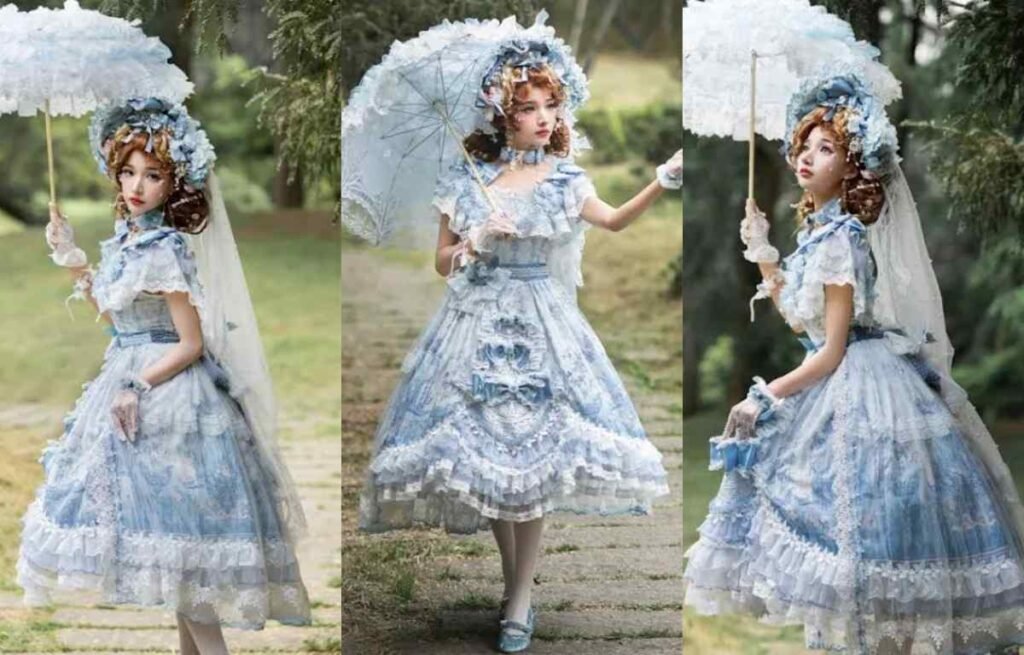
Lolita Dress: A Blend of Innocence, Fantasy, and Subculture Fashion
The Lolita dress is a fashion statement rooted in Japanese street culture, inspired by Victorian and Rococo styles.
It typically features a fitted bodice, puffed sleeves, and a full skirt with petticoats, often adorned with lace, ribbons, and bows. It creates a youthful, doll-like look that emphasizes modesty and elaborate detail.
What makes a Lolita dress unique in modern fashion?
The Lolita dress is more than just a cute outfit—it’s a subculture with a strong identity.
Its uniqueness lies in the dramatic silhouette, historical references, and intricate decoration, all serving to create a distinct, romantic fantasy aesthetic.
The Structure and Symbolism of Lolita Fashion
The Lolita dress is part of a full lifestyle aesthetic with deep cultural roots. Let’s break down its appeal from a fashion and design perspective.
Key Style Elements
Lolita fashion follows a strict set of design codes that set it apart:
- Silhouette: A-line or bell-shaped skirts with visible petticoats
- Necklines: Often Peter Pan collars, square necks, or sweetheart shapes
- Sleeves: Puff sleeves or long sleeves with lace cuffs
- Details: Lace trim, frills, bows, corset lacing, and embroidered motifs
- Accessories: Bonnets, knee-high socks, parasols, and platform Mary Janes
These elements aim to evoke a sense of innocence, elegance, and refinement—often contrasting with modern minimalism.
Substyles of Lolita
Lolita fashion isn’t just one style—it’s a collection of substyles, each with its own mood:
| Substyle | Description | Color Palette |
|---|---|---|
| Sweet Lolita | Cute, pastel, filled with bows & prints | Pink, lavender, white |
| Classic Lolita | Elegant, mature, historically inspired | Ivory, navy, burgundy |
| Gothic Lolita | Dark, romantic, often monochrome | Black, deep reds, purples |
| Punk Lolita | Edgy, includes tartan, zippers, studs | Red, black, grey |
Each substyle plays with the same structure but expresses a different identity.
Cultural Impact and Global Influence
Lolita started as a rebellion against Japanese mainstream fashion and gender roles. It became a way for young women to reclaim femininity on their own terms—not for male gaze, but for self-expression.
Today, Lolita is embraced worldwide through online communities, conventions, and fashion shows. It has influenced Western designers, pop culture, and even K-pop visuals.
Fabric & Construction Considerations
Because of its detail, Lolita dresses require specific construction:
- Main Fabrics: Cotton blends, velvet, jacquard, and chiffon
- Lining & Layers: Often lined, with built-in or separate petticoats
- Trims: Embroidered lace, organza ruffles, ribbon corseting
- Fastenings: Back zippers or corset ties for adjustable fit
These materials help the dress maintain its volume and ornate finish.
How to Style a Lolita Dress Today?
Wearing Lolita doesn’t have to be all or nothing.
Pair it with modern elements like a leather jacket or sneakers for a casual twist, or go full-out with matching accessories for authenticity.
It can be worn for themed events, fashion shoots, or even as a form of personal style for everyday wear—depending on how bold you want to go.
Bohemian Maxi Dress
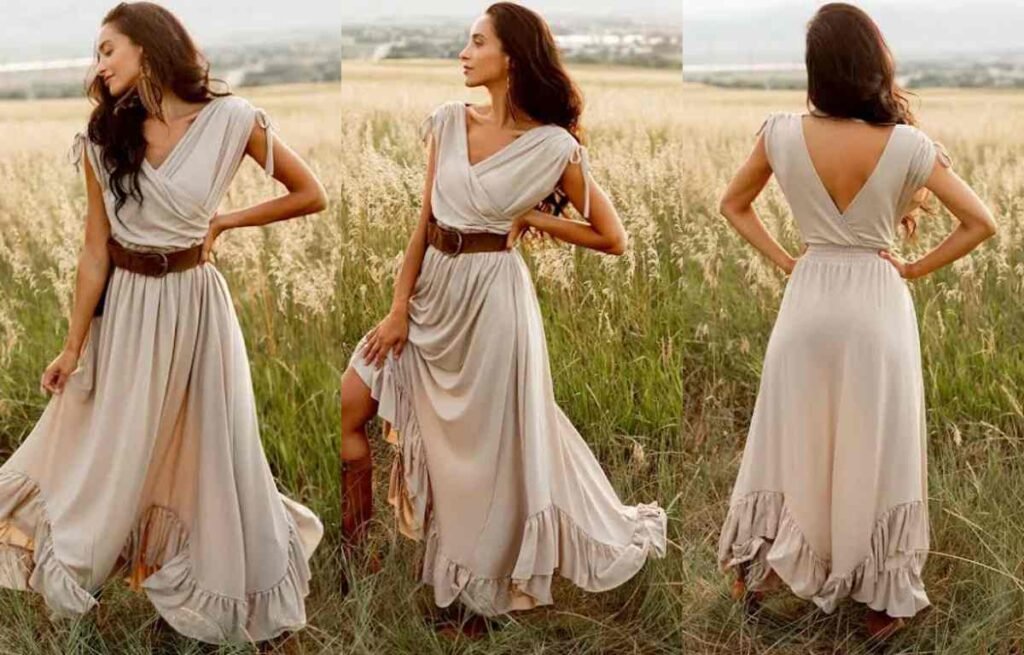
Bohemian Maxi Dress: Flowing Style with a Free Spirit
The Bohemian Maxi Dress blends relaxed elegance with artistic expression. It’s a full-length dress often made from lightweight, breathable fabrics and known for its flowy silhouette.
Defined by earthy colors, ethnic prints, and loose cuts, this dress style captures a carefree, romantic vibe perfect for casual or resort wear. It’s a favorite for summer, travel, and creative wardrobes.
Why is the bohemian maxi dress so loved?
It’s all about comfort, ease, and effortless style.
The bohemian maxi dress offers a relaxed fit while still feeling elegant. Its long, flowing shape flatters many body types and works well across seasons when layered correctly.
What Makes the Boho Maxi Dress Unique?
This dress isn’t just a fashion trend—it’s a design rooted in culture, comfort, and individuality. Let’s explore its deeper appeal:
Freedom of Movement and Form
The bohemian maxi dress embraces natural body movement. Its loose structure allows for air circulation, making it a go-to for warm climates or travel. Unlike fitted dresses, this one doesn’t restrict the waist or hips, offering comfort without compromising on style.
- For petite wearers: Pairing with a belt or platform sandals prevents the dress from overwhelming the frame.
- For taller figures: The length and volume balance the silhouette and enhance presence.
Cultural and Artistic Influence
Boho fashion borrows from global traditions—India, Morocco, Latin America—bringing together embroidery, patchwork, paisley, and ethnic motifs. These influences are visible in trims, prints, and fabric mixing.
Designers often incorporate:
- Floral or paisley prints
- Crochet or lace inserts
- Tassels, fringe, and embroidery
- Tie-dye and hand-painted patterns
Versatility and Layering
Though often associated with summer, the boho maxi dress adapts well to all seasons:
- Spring/Summer: Worn with sandals or barefoot for a beachy feel.
- Fall/Winter: Layer with knit cardigans, boots, and scarves for a cozy look.
- Festival or Travel: Styled with hats, belts, or statement jewelry for individuality.
Sustainability and Slow Fashion
Many boho dresses are made using natural fibers like cotton, viscose, or hemp. Brands that focus on boho fashion often align with eco-conscious or artisanal production, reinforcing the lifestyle’s values of freedom and sustainability.
Bohemian vs. Other Maxi Dress Styles
| Feature | Bohemian Maxi Dress | Evening Maxi Dress | Wrap Maxi Dress |
|---|---|---|---|
| Fit | Loose, flowy | Fitted, structured | Adjustable, flexible |
| Fabric | Cotton, rayon, gauze | Silk, satin | Jersey, crepe |
| Vibe | Relaxed, artistic | Glamorous, formal | Casual to dressy |
| Print/Detail | Ethnic, floral, lace | Solid colors, shimmer | Minimal or printed |
Best Fabrics for Bohemian Maxi Dresses
The feel of the dress relies on fabric. Boho styles favor:
- Rayon/Viscose: Lightweight and breathable with a soft drape.
- Cotton: Natural and comfortable for everyday wear.
- Crinkled gauze: Adds texture and depth.
- Chiffon or georgette: Great for layering without weight.
Styling Tips for the Boho Maxi Dress
- Footwear: Sandals, espadrilles, or suede boots.
- Accessories: Layered necklaces, big earrings, straw hats.
- Outerwear: Denim jacket or oversized cardigan for colder days.
- Shape control: Add a waist belt for more definition if needed.
Dirndl Dress
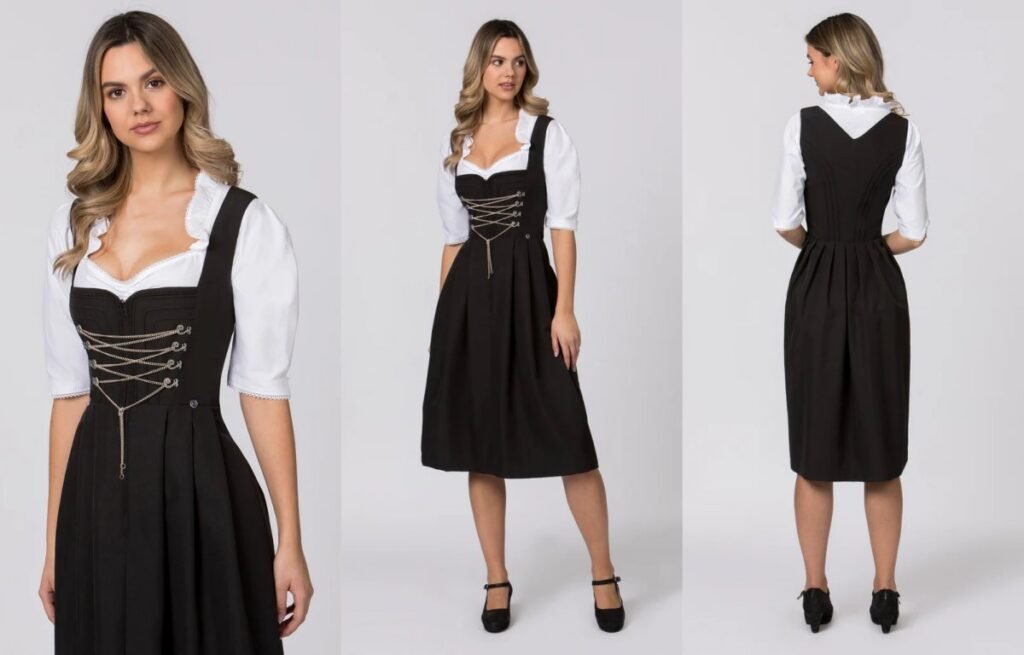
Dirndl Dress: Traditional Roots, Modern Revival
The Dirndl dress is a traditional European garment with deep cultural roots, especially in Alpine regions like Austria, Germany, and Switzerland.
It features a fitted bodice, a full skirt, and usually includes a blouse and apron, creating a structured, feminine silhouette. Though rooted in folkwear, the dirndl has found a modern place in fashion thanks to its flattering shape and timeless charm.
What makes the Dirndl dress unique in modern fashion?
The dirndl stands out for its historical depth and its ability to evolve with trends.
It combines structure and femininity, offering a cinched waist, flared skirt, and versatile layering elements. It’s both cultural and adaptable, making it suitable for costume events, regional festivals, or fashion reinterpretations.
Understanding the Dirndl’s Lasting Appeal
The dirndl isn’t just a regional costume—it’s a symbol of identity, tradition, and feminine elegance. Let’s explore what gives it its distinctive place in women’s fashion.
Core Elements of a Dirndl Dress
A typical dirndl consists of three parts:
- Bodice: Often laced or buttoned, it defines the waist and bust.
- Blouse: Usually cropped with puffed sleeves and a square or rounded neckline.
- Skirt and Apron: The skirt is full and often knee- or ankle-length, while the apron adds volume and visual layering.
Each element contributes to the dirndl’s signature hourglass shape. The dress flatters the waist while enhancing the hips and bust.
Symbolism in Styling
In traditional contexts, the placement of the apron tie can signify relationship status:
- Tied on the left: Single
- Tied on the right: Taken
- Tied in the center: Virgin
- Tied at the back: Widowed or working staff
Though not always followed today, this custom adds depth to the garment’s cultural meaning.
Dirndl in Contemporary Fashion
Modern dirndls maintain the silhouette but often update the details:
- Minimalist versions in plain colors, made from linen or silk
- Casual adaptations without aprons, paired with sneakers or boots
- Luxury designs for events, made with velvet, lace, or metallic fabrics
These updates allow the dirndl to move beyond festivals into high fashion, weddings, or heritage-inspired collections.
Dirndl vs. Other Traditional Dresses
| Dress Style | Region of Origin | Structure | Key Feature |
|---|---|---|---|
| Dirndl | Alpine Europe | Fitted bodice, full skirt | Apron, blouse layering |
| Cheongsam (Qipao) | China | Straight, form-fitting | High collar, side slits |
| Kimono | Japan | T-shaped, loose wrap | Obi belt, wide sleeves |
| Hanbok | Korea | High waist, flared skirt | Jeogori jacket, rich colors |
Best Fabrics and Styling Tips for Dirndl Dresses
- Traditional Fabrics: Cotton, linen, wool—ideal for authentic looks
- Modern Materials: Silk, velvet, satin—for a fashion-forward version
- Styling Tips:
- Pair with ankle boots for a casual modern twist
- Swap traditional blouses with sheer or lace options
- Layer with cropped jackets or denim for street style fusion
Abaya Dress
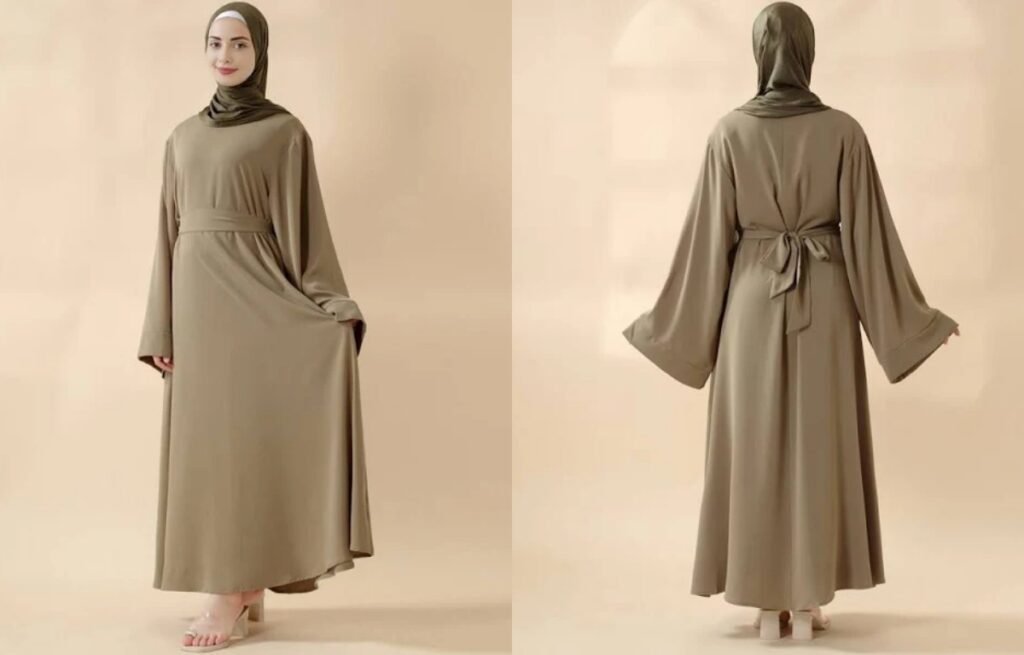
Abaya Dress: Tradition Meets Modern Elegance
The Abaya dress is a long, flowing garment traditionally worn in many Middle Eastern countries, known for its modesty and graceful silhouette.
It’s typically a loose, robe-like dress that covers the whole body except the face, hands, and feet—often worn over other clothing. While rooted in tradition, modern abayas come in various fabrics, cuts, and embellished styles.
I first saw the elegance of the abaya in Dubai—a minimal black design with subtle gold embroidery that looked both powerful and refined.
What makes the Abaya dress unique in today’s fashion?
The abaya stands out for its balance of modesty and style. It’s more than a cultural garment—it’s evolving into a global fashion statement.
It offers full coverage while still allowing expression through fabric, detailing, and silhouette. The abaya is now seen on runways and worn by women across different backgrounds for both religious and fashion reasons.
The Cultural, Functional, and Design Depth of Abayas
The abaya is not just a piece of clothing—it represents identity, tradition, and increasingly, style innovation. Here’s why the abaya continues to grow in global appeal:
Cultural Significance
Originally worn in Islamic cultures to align with modest dress codes, the abaya remains a symbol of cultural respect and identity. In many regions, it’s an everyday essential for women.
However, as the global fashion industry grows more inclusive, abayas are now available in varied colors, patterns, and tailored shapes—transforming the traditional robe into a versatile fashion piece.
Function and Comfort
Its flowing design allows for comfort in hot climates, especially when made from breathable fabrics like crepe, chiffon, or cotton blends. The abaya’s loose fit provides ease of movement while maintaining modesty.
Some abayas also include built-in belts or buttons, giving women the flexibility to adjust the shape based on occasion or preference.
Modern Design Innovations
Contemporary abaya dresses feature:
- Tailored cuts: A-line, kimono sleeves, or wrap styles
- Decorative elements: Lace trims, embroidery, beadwork
- Practical features: Front zippers, layered designs, pockets
- Seasonal fabrics: Lightweight for summer, wool blends for winter
Designers now explore abayas beyond religious or regional use—creating collections that blend modest fashion with global trends.
Abaya vs. Similar Modest Dress Styles
| Dress Style | Coverage | Origin/Influence | Common Fabrics | Styling Focus |
|---|---|---|---|---|
| Abaya | Full body | Middle East | Crepe, chiffon | Loose, flowing |
| Kaftan | Loose fit | North Africa, Middle East | Silk, cotton | Draping, prints |
| Maxi Dress | Full length | Western fashion | Jersey, rayon | Fit & flare, casual |
| Jilbab | Full body | Islamic wear | Polyester, cotton | Modest, layered look |
What fabrics and styling details elevate an Abaya dress?
Fabric plays a key role in both comfort and elegance.
Premium abayas often use crepe, silk, or chiffon for softness and movement, while cotton blends offer breathability for daily wear. Embellishments like lace or metallic threads add luxury for formal events.
Popular Styling Features:
- Open-front styles for layering
- Batwing or kimono sleeves for volume
- Belted waists to add subtle shape
- Monochrome or neutral palettes for timeless appeal
- Minimalist gold or black embroidery for understated luxury
Hanfu-inspired Dress
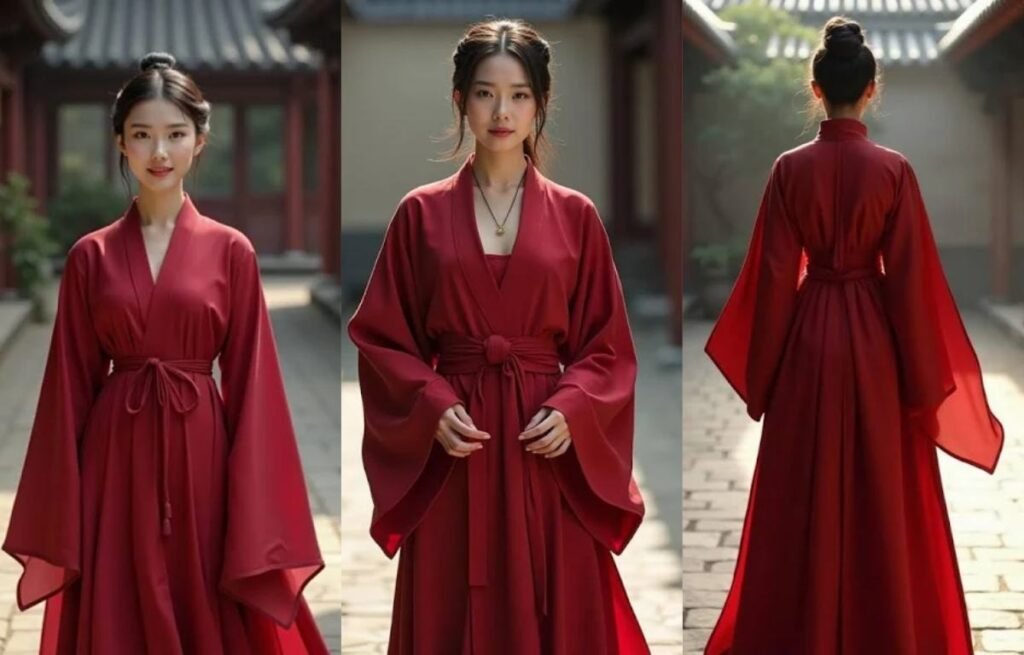
Hanfu-Inspired Dress: Traditional Beauty in Modern Form
The Hanfu-inspired dress brings ancient Chinese aesthetics into contemporary fashion, combining elegance with cultural depth.
It’s a modern adaptation of traditional Hanfu garments, often featuring crossed collars, flowing sleeves, layered fabrics, and a belted waist. This style blends heritage and fashion, making it unique in today’s dress landscape.
Why is the Hanfu-Inspired Dress gaining global appeal?
Hanfu-inspired dresses stand out for their flowing structure, soft drape, and rich cultural detail.
They offer graceful silhouettes with cultural symbolism, appealing to fashion lovers who value history, craftsmanship, and beauty.
The Design Depth of Hanfu-Inspired Dresses
Although inspired by historical Han Chinese clothing, this dress style isn’t a direct replica. It merges traditional elements with wearable, modern-day designs. Here’s why it’s growing in popularity:
Core Design Elements
- Cross-collar (交领): A defining feature, where the neckline folds diagonally across the chest.
- Flowing Sleeves: Inspired by the quju and zhiju robes, sleeves are wide, often bell-shaped, and create movement.
- Layering: Hanfu styles traditionally involved multiple layers. Modern versions simplify this with layered panels or printed illusions.
- Ribbon Waist or Sash Belt: Often tied high to mimic the Han dynasty silhouette, enhancing waistlines and elongating the figure.
These design cues preserve the poetic movement and symbolism of Hanfu while adapting it to everyday wear.
Cultural Symbolism
Each element has meaning:
- Sleeves represent openness and elegance.
- Layered garments show modesty and dignity.
- Nature motifs like cranes, clouds, and plum blossoms symbolize grace, longevity, or resilience.
Modern consumers are increasingly drawn to pieces that “tell a story,” and Hanfu-inspired dresses do exactly that.
Fit for Various Occasions
Unlike traditional Hanfu, which is reserved for festivals or cultural events, Hanfu-inspired dresses are:
- Casual-friendly: In lightweight cotton or chiffon for daily wear.
- Event-appropriate: In silk or satin, ideal for weddings, banquets, or creative formal events.
- Creative pieces: Blending East-meets-West, they pair well with boots, sneakers, or even structured blazers.
Hanfu-Inspired vs. Other Flowing Dress Styles
| Feature | Hanfu-Inspired Dress | Boho Dress | Kimono Dress |
|---|---|---|---|
| Cultural origin | China (Han Dynasty) | Western folk | Japan (traditional) |
| Key feature | Cross-collar, sash waist | Lace, prints, fringe | Straight sleeves, belt |
| Silhouette | Flowing, layered | Relaxed, A-line | Straight, wrap-style |
| Mood | Graceful, serene | Free-spirited | Minimalist, refined |
Best Fabrics for Hanfu-Inspired Dresses
- Chiffon: Light and airy, great for modern flow.
- Silk or Satin: Luxurious, perfect for formalwear.
- Rayon or Viscose: Offers a soft drape with good movement.
- Embroidered Fabrics: Add authenticity and visual richness.
Styling Tips
- Hair: Try soft waves, braided crowns, or hairpins to complement the historical feel.
- Shoes: Pair with embroidered flats, Mary Janes, or minimalist sandals.
- Accessories: Subtle earrings, jade pendants, or vintage hair combs enhance the look.
Metallic Dress
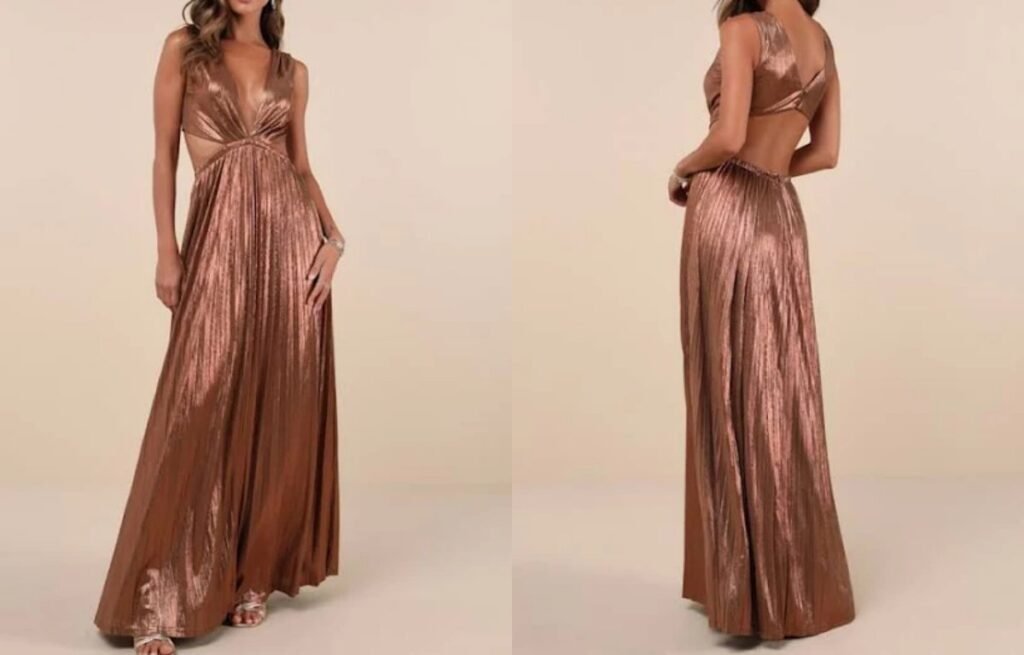
Metallic Dress: Shine That Demands Attention
The metallic dress is bold, eye-catching, and built to stand out. It’s a go-to choice for parties, night events, or any occasion where you want to turn heads.
Metallic dresses are made from fabrics with a shiny, reflective surface—often featuring foil prints, lamé, or metallic threads. They instantly add drama and glamour to any outfit.
Why are metallic dresses so iconic for nightwear and events?
It’s all about presence. A metallic finish adds light, energy, and a modern edge to the look.
Metallic dresses reflect light and movement, making the wearer the center of attention. They’re perfect for eveningwear, holiday looks, or red-carpet moments when you want maximum visual impact.
The Design Impact of Metallic Dresses
Though often seen as flashy, metallic dresses require smart design choices to balance shine with sophistication.
Visual Texture and Depth
Metallic fabrics don’t just reflect light—they add depth and dimension to the garment. Even a minimal design becomes bold with a metallic finish. That’s why designers often keep the silhouette simple: to let the fabric speak.
- Smooth metallics (like liquid lamé or foil spandex) create a sleek, futuristic look.
- Textured metallics (like jacquards with metallic thread) offer a more refined, couture feel.
Strategic Use of Silhouettes
Metallic dresses work best when the silhouette complements the intensity of the fabric. Common pairings include:
- Slip or bodycon: Clean lines balance the bold fabric.
- Wrap or draped styles: Add softness to the shine.
- Structured mini dresses: Offer a bold, youthful edge.
Too many details can overwhelm. Keep ruffles, lace, or embellishments to a minimum unless the metallic fabric is subtle.
Color Tones and Skin Matching
Metallics aren’t limited to silver or gold. They come in shades like rose gold, gunmetal, bronze, or metallic navy.
- Silver tones work well with cool undertones.
- Gold and bronze flatter warm skin tones.
- Rose gold is more neutral and universally flattering.
This makes metallic dresses more adaptable than most people expect.
Styling Matters
Metallics already make a statement. So styling should balance, not compete.
- Keep accessories minimal: Think simple heels and clutch.
- Avoid high-shine jewelry: Go for matte or small-scale pieces.
- Hair and makeup: Let the dress be the focus—opt for a clean look.
Metallic vs. Other Statement Fabrics
| Fabric Type | Shine Level | Mood | Common Use |
|---|---|---|---|
| Metallic | High | Bold, glamorous | Parties, evening events |
| Sequin | Very High | Festive, playful | Clubwear, performances |
| Satin | Medium | Elegant, soft | Formal, romantic looks |
| Velvet | Low | Rich, moody | Winter/formal fashion |
Best Fabrics for Metallic Dresses
- Lamé: Lightweight with high shine, often used in partywear.
- Foil Jersey: Stretchy and clingy with a liquid-metal finish.
- Metallic Jacquard: Adds structure and texture for upscale designs.
- Tulle with metallic thread: Used for layered, airy evening looks.
Styling Tips
- Choose simple silhouettes to avoid clashing with the fabric’s boldness.
- Stick with neutral heels and small bags.
- Let the dress shine—avoid competing statement pieces.
Sequin Dress
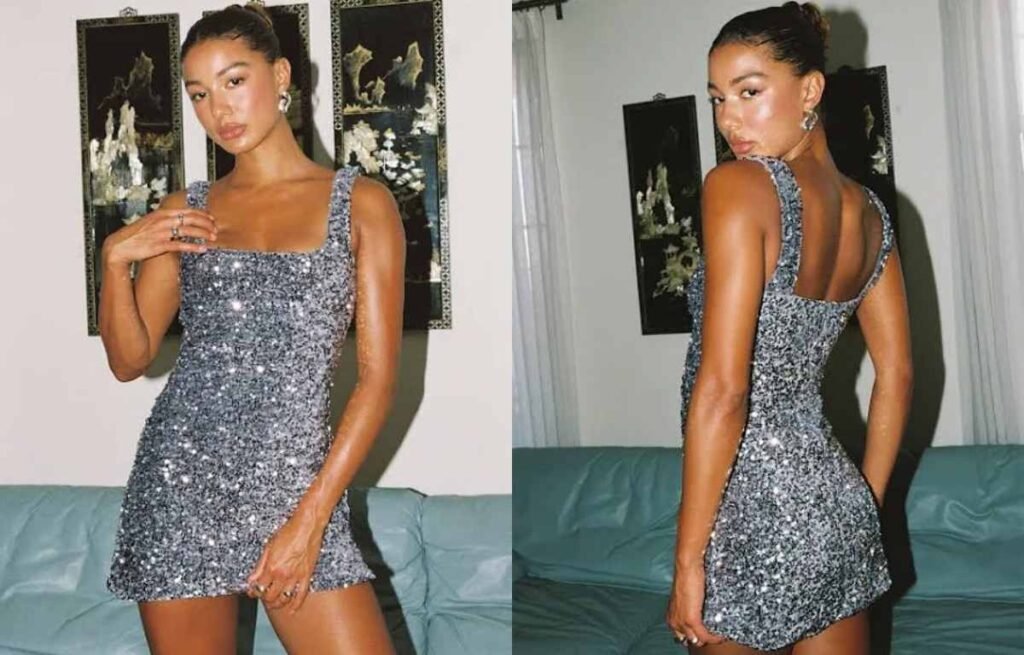
Sequin Dress: Bold, Glamorous, and Ready to Shine
The sequin dress is all about sparkle and drama. It’s the go-to choice for parties, red carpets, and moments when you want all eyes on you.
A sequin dress is typically covered in reflective embellishments that catch the light, creating a shimmering effect that stands out in any setting. It’s bold, luxurious, and makes an instant statement.
Why is the sequin dress such a statement piece?
Because it reflects both light and attention.
Sequin dresses are designed to shine, literally and figuratively. Whether short or long, fitted or flowy, they instantly elevate the look and mood of the wearer.
What makes sequin dresses work—and when they don’t
1. Visual Impact and Occasion Power
Sequin dresses create visual intensity. They catch the light with every movement, making them ideal for events where visibility matters—think New Year’s Eve, cocktail parties, or stage performances.
But because of their high-shine finish, they can easily overpower a look if not styled carefully. Choosing the right silhouette, color, and accessory pairing is crucial.
2. Fit and Fabric Balance
Sequin fabric tends to be stiff, so the dress needs careful construction to maintain comfort and mobility. Lining plays a big role here. A well-lined sequin dress prevents scratchiness and helps the garment drape properly.
For body-hugging styles, stretch-mesh bases are common. For more structured designs, woven fabrics offer better shape retention.
3. Silhouette Options
Different dress shapes create different effects:
- Bodycon Sequin Dress: Great for showing off curves. Best with minimal accessories.
- A-Line Sequin Dress: Easier to wear for more body types. Balanced glam.
- Wrap Sequin Dress: Combines sparkle with a flattering shape.
- Sequin Gown: Full-length drama for formal events and galas.
4. Color Strategy
Color changes everything. Metallic tones like gold, silver, and bronze bring full glamour. Black or navy versions feel more wearable. Iridescent or colored sequins make the dress trend-driven and youthful.
| Color | Vibe | Best Occasion |
|---|---|---|
| Gold/Silver | High glamour | Red carpet, evening galas |
| Black/Navy | Elegant and classic | Formal dinners, night events |
| Pink/Blue | Trendy and playful | Birthdays, fashion parties |
5. Styling Do’s and Don’ts
- Do pair with simple heels and a small clutch.
- Don’t wear too many sparkly accessories—it can look overwhelming.
- Do consider a sleek hairstyle or a bold lip.
- Don’t layer heavy jackets—it clashes with the texture.
6. Day-to-Night Potential
Short sequin dresses in muted colors can work for semi-formal day events, especially with casual elements like a denim jacket or boots. But they truly shine at night. For versatility, look for pieces that blend matte fabrics with sequin panels.
Best Fabrics for Sequin Dresses
- Mesh with Stretch: For fitted silhouettes
- Tulle Base with Sequins: Light and romantic
- Woven Base with Full Sequins: Structured and sculptural
- Velvet or Satin Mix: Adds texture depth and richness
Fringe Dress
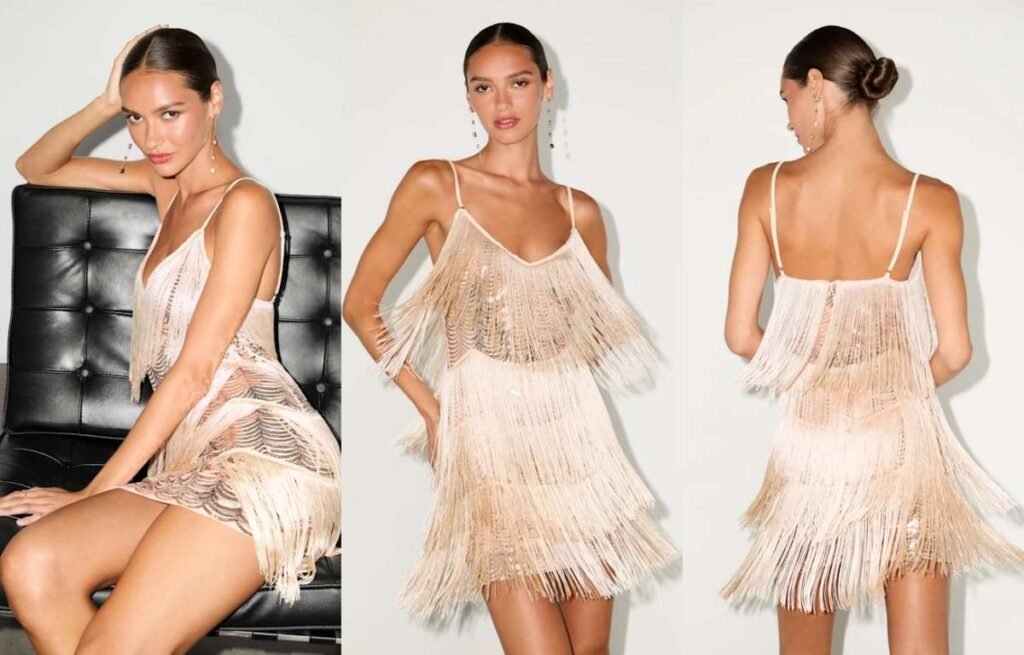
Fringe Dress: Movement, Texture, and Vintage Flair
The fringe dress is a bold style that adds texture and movement to any look. Its roots go back to vintage and bohemian fashion, but it’s now seen in modern streetwear and eveningwear.
A fringe dress features strips of fabric, leather, or thread hanging from the dress—usually on the hem, sleeves, or throughout the body—to create dynamic motion as the wearer moves. It’s eye-catching, fun, and full of personality.
Why is the fringe dress such a statement piece?
Fringe brings drama and texture to even the simplest silhouette.
Fringe dresses stand out because they’re constantly in motion. Whether you’re walking or dancing, the layered strands catch the light and create a fluid, energetic look. It’s a favorite for both retro and festival styles.
What Makes Fringe Dresses So Unique?
Fringe dresses aren’t just about aesthetics—they represent a fusion of history, design detail, and emotional impact. Here’s why they work across various fashion contexts:
Historical Influence
Fringe dresses are often associated with 1920s flapper style, when women wore loose, drop-waist dresses with fringe for dancing. They also appear in Western, Native American, and boho styles—each using fringe as both decoration and symbolism (freedom, rebellion, or rhythm).
Today, fringe continues to be used in both nostalgic and modern contexts, depending on how it’s styled.
Visual Movement
Fringe is one of the only dress elements that adds movement without requiring the wearer to move dramatically. Even a simple step causes the fringe to sway, making the garment come alive. This visual rhythm is perfect for performances, photoshoots, or statement moments on stage or at parties.
Designers often use this to their advantage—placing fringe in strategic layers to lengthen the body, add volume, or draw attention to a specific area (like hips or arms).
Texture and Layering
Fringe provides instant texture. A plain silhouette becomes interesting with just one row of fringe. It can also be layered in tiers to add depth.
- Long vertical fringe: Elongates the body
- Short layered fringe: Adds volume and bold texture
- Diagonal or asymmetrical fringe: Creates visual direction and edge
The placement of fringe matters. It can highlight curves or create new lines that reshape the body’s appearance.
Styling Adaptability
Fringe dresses aren’t just for themed parties. Depending on fabric and cut, they fit many styles:
- Bohemian: Light fabrics with fringe details at the hem or sleeves
- Glam/Evening: Metallic or sequined fringe on a bodycon silhouette
- Festival: Leather or crochet fringe paired with boots
- Streetwear: Minimalist dresses with edgy fringe accents
Fringe vs. Ruffle or Pleated Dresses
| Feature | Fringe Dress | Ruffle Dress | Pleated Dress |
|---|---|---|---|
| Movement | High, dynamic | Moderate, soft | Controlled, structured |
| Texture | String-like, layered | Flowing, wavy | Linear, folded |
| Style Origin | 1920s, boho, Western | Romantic, girly | Classic, formal |
| Visual Effect | Dramatic, fun | Feminine, soft | Clean, polished |
Best Fabrics for Fringe Dresses
The choice of base fabric and fringe material affects the entire look.
- Base fabrics: Jersey, satin, suede, mesh, or velvet
- Fringe materials: Rayon thread, leather strips, sequins, chains, or beaded strands
Pairing a structured base with fluid fringe creates a balanced contrast between form and motion.
Styling Tips
- Keep accessories minimal—let the dress speak for itself.
- Choose shoes that enhance movement, like heels or boots.
- For modern looks, pair fringe with sleek hair and clean makeup.
- For boho/festival looks, add a wide-brim hat or layered jewelry.
Lace Dress
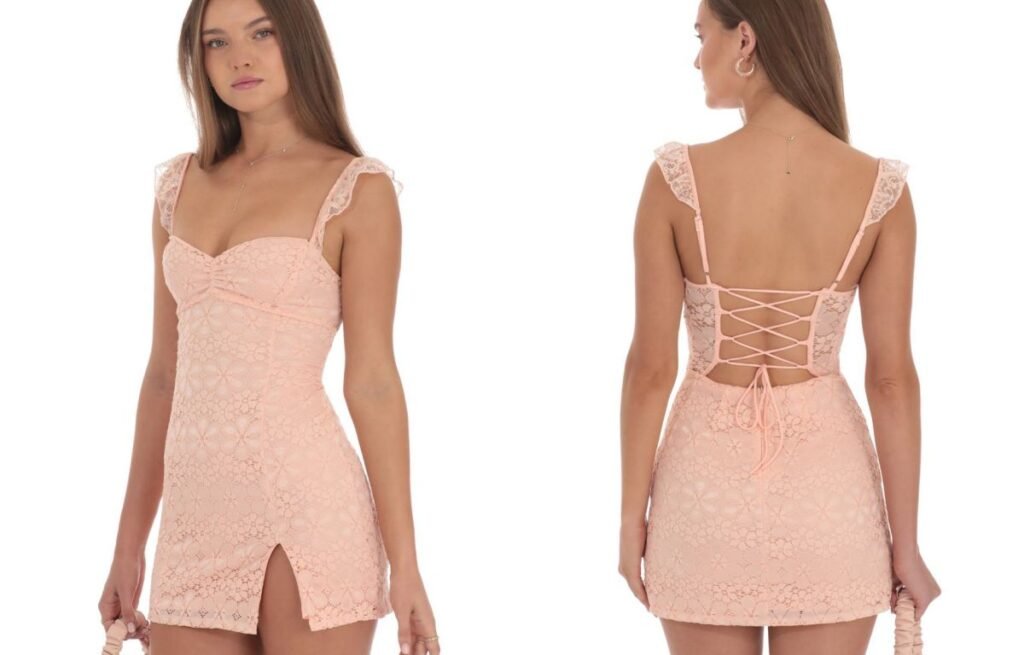
Lace Dress: Timeless, Romantic, and Always in Style
The lace dress is one of the most iconic and enduring pieces in women’s fashion. It speaks to elegance, femininity, and detail.
Lace dresses use intricate openwork fabrics to add texture and romance to the silhouette. Whether short or long, casual or formal, this style brings refinement to any wardrobe.
Why is the lace dress a must-have in modern fashion?
A lace dress is more than just beautiful—it’s also surprisingly versatile.
Its detail-rich fabric creates instant visual interest while working across multiple dress shapes and occasions. From bridalwear to casual day dresses, lace adapts to different moods effortlessly.
Why Lace Dresses Remain a Fashion Staple
Lace dresses carry deep roots in fashion history, yet remain relevant in modern design. Here’s why they continue to thrive:
Texture That Speaks Without Prints
Unlike prints or embellishments, lace provides built-in visual depth. Its open patterns add complexity without overpowering the garment. Depending on the lace type—Chantilly, Guipure, or eyelash—designers can create entirely different moods.
- Chantilly lace is fine and romantic—ideal for bridal or eveningwear.
- Guipure lace is bolder, with a heavy structure—perfect for cocktail or casual dresses.
- Eyelash lace adds soft, feathery edges—great for details like sleeves or hems.
Lace as a Layering Tool
Lace is often used as an overlay or contrast fabric:
- Overlay: A lace layer on top of lining creates a soft-focus effect, often used in occasion wear.
- Inserts and cutouts: Used for peekaboo effects in sleeves, waists, or necklines.
- Full lace: When unlined, the lace creates sheer drama—great for evening events with the right styling.
This allows lace dresses to range from modest and vintage to bold and fashion-forward.
Works Across Dress Types
Lace isn’t limited to one silhouette. You’ll find it in:
- Sheath lace dresses: Clean and modern for events or office-to-evening looks.
- Fit-and-flare styles: Feminine and flattering, often seen at weddings or garden parties.
- Boho maxis: Flowy lace combined with tiered shapes works well in casual settings.
- Bodycon lace dresses: Perfect for date nights or parties—fitted with added texture.
Lace vs. Other Textured Dresses
| Dress Style | Texture Source | Vibe | Best Use |
|---|---|---|---|
| Lace Dress | Openwork fabric | Romantic, elegant | Bridal, evening, casual |
| Embroidered Dress | Thread detailing | Artistic, folk | Daywear, boho, casual |
| Beaded Dress | Beads, sequins | Glamorous | Formal parties |
| Printed Dress | Surface print | Trendy | Everyday, vacation |
What Fabrics Work Best with Lace Dresses?
Lace is typically paired with a base or lining fabric for comfort and contrast.
Common pairings include satin, chiffon, stretch jersey, or tulle. These help the lace fall well and ensure it’s wearable across styles—from form-fitting to flowy.
For structure, cotton or polyester-based laces are used. For softness, nylon blends or silk-based laces are better.
Styling Tips for Lace Dresses
- Accessories: Keep jewelry minimal if the lace is detailed.
- Shoes: Heels for formal lace, flats or sandals for casual versions.
- Layering: Add a blazer or denim jacket for contrast in casual looks.
- Undergarments: Nude or tonal slips work best with sheer lace sections.
Transparent / Sheer Dress
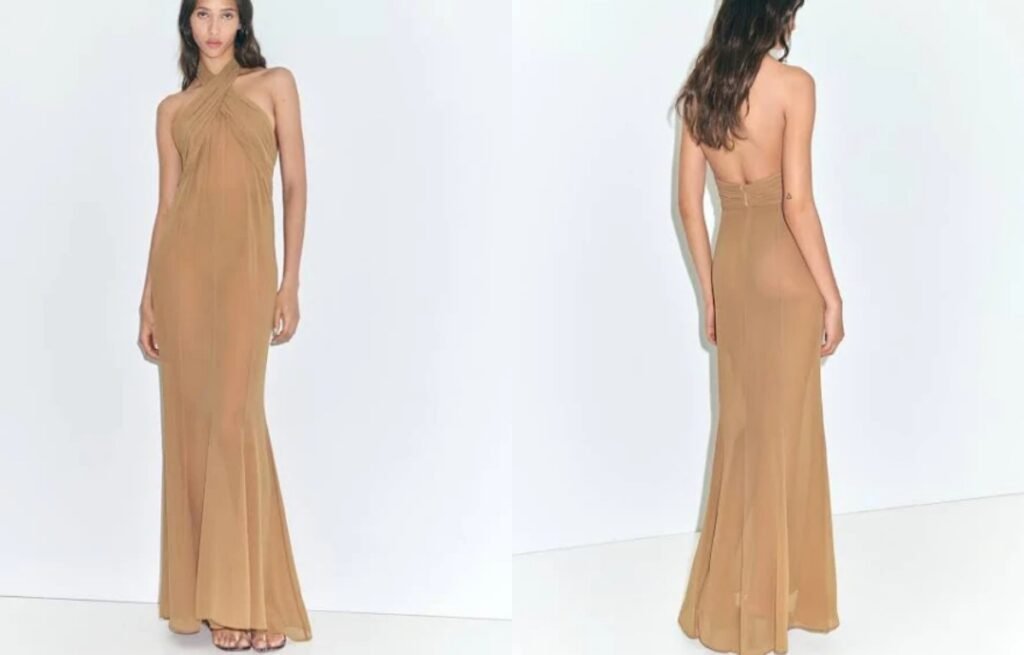
Transparent / Sheer Dress: Bold, Delicate, and Fashion-Forward
The transparent or sheer dress is a fashion statement that balances sensuality and elegance through lightweight, semi-transparent fabrics.
Sheer dresses use materials like chiffon, tulle, mesh, or organza to reveal skin or layers underneath while maintaining a sense of style and sophistication. They can be subtle or daring depending on the layering, cut, and fabric opacity.
Why are transparent dresses gaining popularity?
Sheer dresses have become runway staples and red carpet favorites.
They offer designers freedom to play with layers, textures, and contrasts—allowing wearers to express confidence, creativity, and modern femininity.
The Design Power Behind Sheer Dresses
Transparent dresses are more than just a trend—they reflect shifts in how fashion embraces boldness, individuality, and styling freedom.
1. Visual Layering
Sheer dresses allow for strategic layering. Designers often pair sheer overlays with:
- Slips (nude or contrast-colored)
- Bodysuits or bralettes
- Mini dresses or skirts
This not only adds depth but creates visual contrast, giving the illusion of dimension even in simple silhouettes.
2. Balancing Exposure and Coverage
One of the biggest strengths of the sheer dress is its ability to reveal without fully exposing. For example:
- A sheer long-sleeve dress with a short slip balances modesty and allure.
- A transparent maxi over high-waisted shorts offers coverage with edge.
This balance appeals to women who want to show skin but still feel comfortably dressed.
3. Fabric Choices Define the Mood
The fabric dramatically changes the feel:
| Fabric Type | Look & Feel | Best For |
|---|---|---|
| Chiffon | Soft, floaty | Romantic, layered styles |
| Tulle | Voluminous, airy | Dramatic, runway looks |
| Mesh | Stretchy, edgy | Streetwear, casual chic |
| Organza | Crisp, structured | High-fashion statements |
Designers use fabric weights and textures to control how revealing the dress is—thicker mesh adds opacity, while lightweight chiffon keeps it ethereal.
4. Body Type Adaptability
Contrary to common belief, sheer dresses aren’t just for model figures. They can be styled for different shapes:
- Petite: Choose lighter layers and vertical elements to elongate.
- Curvy: Use thicker mesh or double layers for flattering coverage.
- Athletic: Add ruffles, tiers, or details to soften the silhouette.
The key is in layering and fabric choice—not in avoiding the trend altogether.
5. Styling Possibilities
Sheer dresses are one of the most versatile pieces when it comes to styling:
- Over a simple slip dress for a classic, wearable look
- Paired with denim and a bralette for a street-style edge
- Worn as a beach cover-up in lighter fabrics like mesh or chiffon
- Layered over trousers for a modern, high-fashion twist
When and Where to Wear Sheer Dresses?
- Evening wear: Sheer gowns with embellished overlays are red carpet staples.
- Streetwear: A mesh dress over a crop top and bike shorts creates an edgy look.
- Vacation: Lightweight sheer maxis work well as beach cover-ups.
- Layered casual: Worn over jeans or a tank dress for everyday styling.
Related Articles
“Types of Dresses: The Ultimate Guide to 80+ Styles Every Woman Should Know(part 1)”
“Types of Dresses: The Ultimate Guide to 80+ Styles Every Woman Should Know(part 2)”
“Types of Dresses: The Ultimate Guide to 80+ Styles Every Woman Should Know(part 3)”


